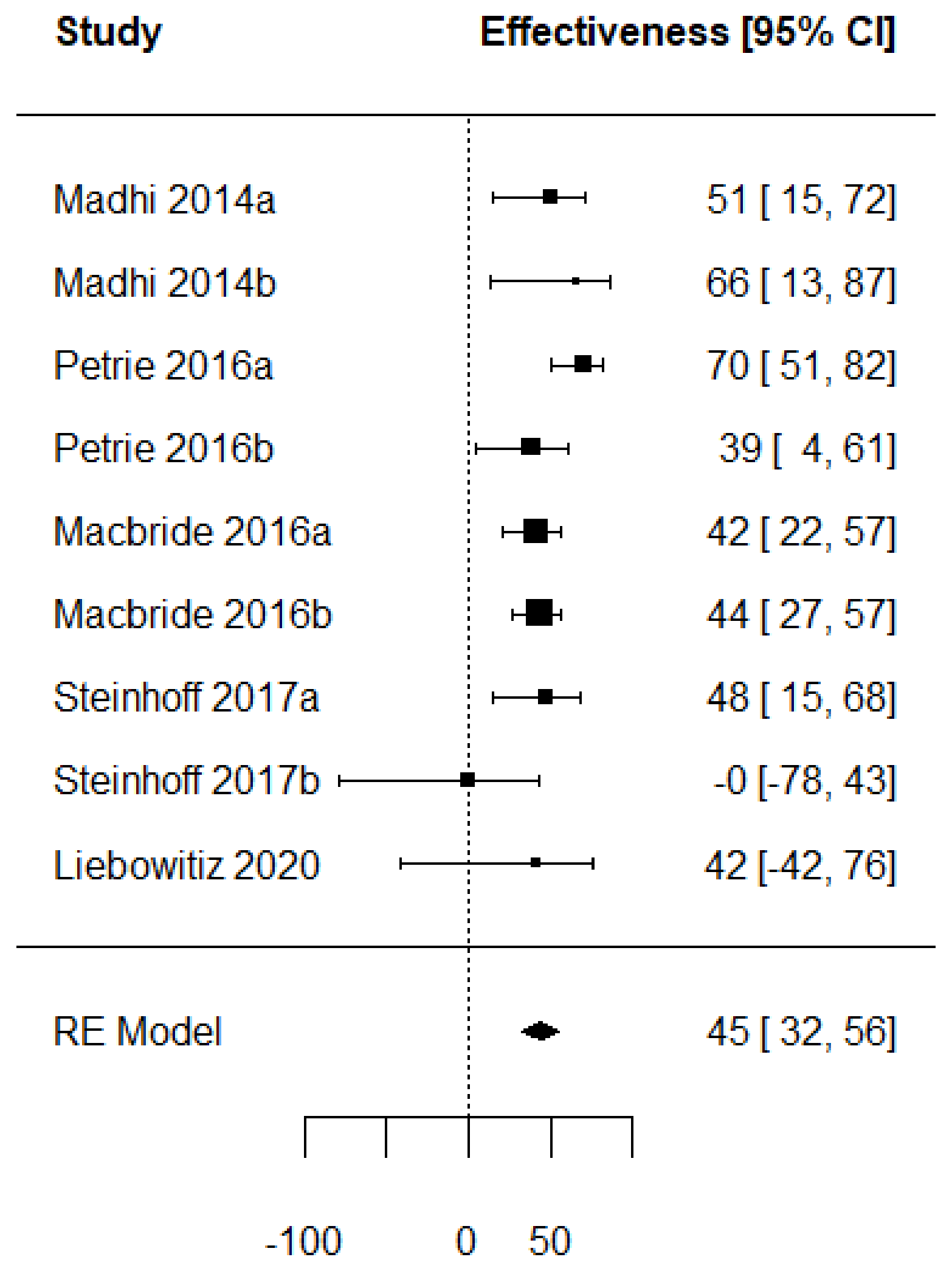Seasonal Influenza Vaccine Effectiveness in Persons Aged 15–64 Years: A Systematic Review and Meta-Analysis
Abstract
1. Introduction
2. Methods
2.1. Search Strategy and Eligibility Criteria
 4.3.0 software [29], package RISmed [30] available at https://www.r-project.org/. The last search date was March 2023. We also screened the reference list of included studies and relevant systematic reviews. The detailed search strategy is available in the register on PROSPERO. Only studies written in English were included to avoid any bias related to a mistranslation.
4.3.0 software [29], package RISmed [30] available at https://www.r-project.org/. The last search date was March 2023. We also screened the reference list of included studies and relevant systematic reviews. The detailed search strategy is available in the register on PROSPERO. Only studies written in English were included to avoid any bias related to a mistranslation.- –
- Inclusion of sufficient information to compute the vaccine efficacy/effectiveness;
- –
- Articles published between 2013 and 2023;
- –
- Influenza was confirmed by a laboratorial method;
- –
- Articles that include the human population aged 15 to 65 years;
- –
- The participants in TNDs must have received a seasonal influenza vaccine at least 14 days before symptoms onset to be regarded as vaccinated;
- –
- Comparator was a placebo (for RCTs) or non-vaccinated (for TND);
- –
- Articles published in English.
2.2. Interventions
2.3. Outcome Measure
2.4. Data Collection and Analysis
 software’s metafor package [31]. When any of the outcome measures were zero, the value of 0.5 was added. The associated confidence intervals are based on the logarithm transformation.
software’s metafor package [31]. When any of the outcome measures were zero, the value of 0.5 was added. The associated confidence intervals are based on the logarithm transformation.2.5. Quality Assessment
3. Results
3.1. Risk of Bias Assessment
3.2. Subgroup Analysis
4. Discussion
Limitations of the Study
5. Conclusions
Supplementary Materials
Author Contributions
Funding
Institutional Review Board Statement
Informed Consent Statement
Data Availability Statement
Conflicts of Interest
Abbreviations
References
- European Centre for Disease Prevention and Control. Systematic Review of the Efficacy, Effectiveness and Safety of Newer and Enhanced Seasonal Influenza Vaccines for the Prevention of Laboratory-Confirmed Influenza in Individuals Aged 18 Years and Over; Publications Office: Luxembourg, 2020. [Google Scholar]
- World Health Organization (WHO). The Global Influenza Surveillance and Response System. Available online: https://www.who.int/initiatives/global-influenza-surveillance-and-response-system (accessed on 1 January 2023).
- WHO Regional Office for Europe. WHO Regional Office for Europe Recommendations on Influenza Vaccination for the 2020/2021 Season during the Ongoing COVID-19 Pandemic; WHO: Copenhagen, Denmark, 2020. [Google Scholar]
- Buchy, P.; Badur, S. Who and When to Vaccinate against Influenza. Int. J. Infect. Dis. 2020, 93, 375–387. [Google Scholar] [CrossRef] [PubMed]
- Sullender, W.M.; Fowler, K.B.; Gupta, V.; Krishnan, A.; Ram Purakayastha, D.; Srungaram VLN, R.; Lafond, K.E.; Saha, S.; Palomeque, F.S.; Gargiullo, P.; et al. Efficacy of Inactivated Trivalent Influenza Vaccine in Rural India: A 3-Year Cluster-Randomised Controlled Trial. Lancet Glob. Health 2019, 7, e940–e950. [Google Scholar] [CrossRef] [PubMed]
- McLean, H.Q.; Belongia, E.A. Influenza Vaccine Effectiveness: New Insights and Challenges. Cold Spring Harb. Perspect. Med. 2021, 11, a038315. [Google Scholar] [CrossRef] [PubMed]
- Sullivan, S.G.; Feng, S.; Cowling, B.J. Potential of the Test-Negative Design for Measuring Influenza Vaccine Effectiveness: A Systematic Review. Expert Rev. Vaccines 2014, 13, 1571–1591. [Google Scholar] [CrossRef]
- Zhang, L.; Jin, P.F.; Li, J.X.; Zhu, F.C. Application of test-negative design in vaccine efficacy evaluation. Zhonghua Liu Xing Bing Xue Za Zhi 2020, 41, 280–283. [Google Scholar]
- Balasubramani, G.K.; Zimmerman, R.K.; Eng, H.; Lyons, J.; Clarke, L.; Nowalk, M.P. Comparison of Local Influenza Vaccine Effectiveness Using Two Methods. Vaccine 2021, 39, 1283–1289. [Google Scholar] [CrossRef]
- Zhang, L.; Wei, M.; Jin, P.; Li, J.; Zhu, F. An Evaluation of a Test-Negative Design for EV-71 Vaccine from a Randomized Controlled Trial. Hum. Vaccines Immunother. 2021, 17, 2101–2106. [Google Scholar] [CrossRef]
- Krammer, F.; Smith, G.J.D.; Fouchier, R.A.M.; Peiris, M.; Kedzierska, K.; Doherty, P.C.; Palese, P.; Shaw, M.L.; Treanor, J.; Webster, R.G.; et al. Influenza. Nat. Rev. Dis. Primers 2018, 4, 3. [Google Scholar] [CrossRef]
- Foppa, I.M.; Ferdinands, J.M.; Chung, J.; Flannery, B.; Fry, A.M. Vaccination History as a Confounder of Studies of Influenza Vaccine Effectiveness. Vaccine X 2019, 1, 100008. [Google Scholar] [CrossRef]
- Valenciano, M.; Kissling, E.; Larrauri, A.; Nunes, B.; Pitigoi, D.; O’Donnell, J.; Reuss, A.; Horváth, J.K.; Paradowska-Stankiewicz, I.; Rizzo, C.; et al. Exploring the Effect of Previous Inactivated Influenza Vaccination on Seasonal Influenza Vaccine Effectiveness against Medically Attended Influenza: Results of the European I-MOVE Multicentre Test-Negative Case-Control Study, 2011/2012-2016/2017. Influenza Other Resp. Viruses 2018, 12, 567–581. [Google Scholar] [CrossRef]
- Scott, A.N.; Buchan, S.A.; Kwong, J.C.; Drews, S.J.; Simmonds, K.A.; Svenson, L.W. Using Population-Wide Administrative and Laboratory Data to Estimate Type- and Subtype-Specific Influenza Vaccine Effectiveness: A Surveillance Protocol. BMJ Open 2019, 9, e029708. [Google Scholar] [CrossRef]
- Álvarez Aldeán, J.; Salamanca, I.; Ocaña, D.; Barranco, J.L.; Walter, S. Effectiveness of Cell Culture-Based Influenza Vaccines Compared with Egg-Based Vaccines: What Does the Literature Say? Rev. Esp. Quim. 2022, 35, 241–248. [Google Scholar] [CrossRef]
- Sahni, L.C.; Naioti, E.A.; Olson, S.M.; Campbell, A.P.; Michaels, M.G.; Williams, J.V.; Staat, M.A.; Schlaudecker, E.P.; McNeal, M.M.; Halasa, N.B.; et al. Sustained Within-Season Vaccine Effectiveness Against Influenza-Associated Hospitalization in Children: Evidence from the New Vaccine Surveillance Network, 2015–2016 Through 2019–2020. Clin. Infect. Dis. 2023, 76, e1031–e1039. [Google Scholar] [CrossRef]
- Feng, S.; Sullivan, S.G.; Tchetgen Tchetgen, E.J.; Cowling, B.J. The Causal Interpretation of “Overall Vaccine Effectiveness” in Test-Negative Studies. Am. J. Epidemiol. 2021, 190, 1993–1999. [Google Scholar] [CrossRef]
- Donzelli, A. Influenza Vaccination in Pregnancy: Careful Assessment Confirms Safety Concerns for the Offspring. Hum. Vaccines Immunother. 2019, 15, 2168–2170. [Google Scholar] [CrossRef]
- Ayling, K.; Fairclough, L.; Buchanan, H.; Wetherell, M.A.; Vedhara, K. Mood and Influenza Vaccination in Older Adults: A Randomized Controlled Trial. Health Psychol. 2019, 38, 984–996. [Google Scholar] [CrossRef]
- Whittaker, A.C.; Gallagher, S.; Drayson, M. Time of Day of Vaccination Does Not Relate to Antibody Response to Thymus-Independent Vaccinations. Vaccine X 2022, 11, 100178. [Google Scholar] [CrossRef]
- Yagovkina, N.V.; Zheleznov, L.M.; Subbotina, K.A.; Tsaan, A.A.; Kozlovskaya, L.I.; Gordeychuk, I.V.; Korduban, A.K.; Ivin, Y.Y.; Kovpak, A.A.; Piniaeva, A.N.; et al. Vaccination with Oral Polio Vaccine Reduces COVID-19 Incidence. Front. Immunol. 2022, 13, 907341. [Google Scholar] [CrossRef]
- Comber, L.; Murchu, E.O.; Jordan, K.; Hawkshaw, S.; Marshall, L.; O’Neill, M.; Teljeur, C.; Ryan, M.; Carnahan, A.; Pérez Martín, J.J.; et al. Systematic Review of the Efficacy, Effectiveness and Safety of High-dose Seasonal Influenza Vaccines for the Prevention of Laboratory-confirmed Influenza in Individuals ≥18 Years of Age. Rev. Med. Virol. 2022, 33, e2330. [Google Scholar] [CrossRef]
- Murchu, E.O.; Comber, L.; Jordan, K.; Hawkshaw, S.; Marshall, L.; O’Neill, M.; Ryan, M.; Teljeur, C.; Carnahan, A.; Pérez, J.J.; et al. Systematic Review of the Efficacy, Effectiveness and Safety of Recombinant Haemagglutinin Seasonal Influenza Vaccines for the Prevention of Laboratory-confirmed Influenza in Individuals ≥18 Years of Age. Rev. Med. Virol. 2022, 33, e2331. [Google Scholar] [CrossRef]
- Díez-Domingo, J.; Torcel-Pagnon, L.; Carmona, A.; Launay, O.; Dos Santos, G.; Rizzo, C.; Haag, M.; Stuurman, A.; Nauta, J.; Vannacci, A.; et al. The Value of Public-Private Collaborative Real-World Evidence Platforms to Monitor Vaccine Performance Post Authorization: DRIVE—A European Initiative. Expert Rev. Vaccines 2022, 21, 1701–1710. [Google Scholar] [CrossRef] [PubMed]
- Boddington, N.L.; Pearson, I.; Whitaker, H.; Mangtani, P.; Pebody, R.G. Effectiveness of Influenza Vaccination in Preventing Hospitalization Due to Influenza in Children: A Systematic Review and Meta-Analysis. Clin. Infect. Dis. 2021, 73, 1722–1732. [Google Scholar] [CrossRef] [PubMed]
- Okoli, G.N.; Racovitan, F.; Abdulwahid, T.; Righolt, C.H.; Mahmud, S.M. Variable Seasonal Influenza Vaccine Effectiveness across Geographical Regions, Age Groups and Levels of Vaccine Antigenic Similarity with Circulating Virus Strains: A Systematic Review and Meta-Analysis of the Evidence from Test-Negative Design Studies after the 2009/10 Influenza Pandemic. Vaccine 2021, 39, 1225–1240. [Google Scholar] [CrossRef] [PubMed]
- Mallory, R.M.; Bandell, A.; Ambrose, C.S.; Yu, J. A Systematic Review and Meta-Analysis of the Effectiveness of LAIV4 and IIV in Children Aged 6 Months to 17 Years during the 2016–2017 Season. Vaccine 2020, 38, 3405–3410. [Google Scholar] [CrossRef]
- Page, M.J.; McKenzie, J.E.; Bossuyt, P.M.; Boutron, I.; Hoffmann, T.C.; Mulrow, C.D.; Shamseer, L.; Tetzlaff, J.M.; Akl, E.A.; Brennan, S.E.; et al. The PRISMA 2020 Statement: An Updated Guideline for Reporting Systematic Reviews. BMJ 2021, 372, n71. [Google Scholar] [CrossRef]
- R Core Team. R: A Language and Environment for Statistical Computing; R Foundation for Statistical Computing: Vienna, Austria, 2023. [Google Scholar]
- Kovalchik, S. Package ‘RISmed. Available online: https://cran.r-project.org/web/packages/RISmed/RISmed.pdf (accessed on 1 January 2023).
- Viechtbauer, W. Conducting Meta-Analyses in R with the Metafor Package. J. Stat. Soft. 2010, 36, 1–48. [Google Scholar] [CrossRef]
- Hartung, J.; Knapp, G.; Sinha, B.K. Statistical Meta-Analysis with Applications; Wiley series in probability and statistics; Wiley: Hoboken, NJ, USA, 2008; ISBN 978-0-470-29089-7. [Google Scholar]
- Shi, L.; Lin, L. The Trim-and-Fill Method for Publication Bias: Practical Guidelines and Recommendations Based on a Large Database of Meta-Analyses. Medicine 2019, 98, e15987. [Google Scholar] [CrossRef]
- Sterne, J.A.; Hernán, M.A.; Reeves, B.C.; Savović, J.; Berkman, N.D.; Viswanathan, M.; Henry, D.; Altman, D.G.; Ansari, M.T.; Boutron, I.; et al. ROBINS-I: A Tool for Assessing Risk of Bias in Non-Randomised Studies of Interventions. BMJ 2016, 355, i4919. [Google Scholar] [CrossRef]
- Madhi, S.A.; Cutland, C.L.; Kuwanda, L.; Weinberg, A.; Hugo, A.; Jones, S.; Adrian, P.V.; van Niekerk, N.; Treurnicht, F.; Ortiz, J.R.; et al. Influenza Vaccination of Pregnant Women and Protection of Their Infants. N. Engl. J. Med. 2014, 371, 918–931. [Google Scholar] [CrossRef]
- Petrie, J.G.; Ohmit, S.E.; Truscon, R.; Johnson, E.; Braun, T.M.; Levine, M.Z.; Eichelberger, M.C.; Monto, A.S. Modest Waning of Influenza Vaccine Efficacy and Antibody Titers During the 2007–2008 Influenza Season. J. Infect. Dis. 2016, 214, 1142–1149. [Google Scholar] [CrossRef]
- Mcbride, W.J.H.; Abhayaratna, W.P.; Barr, I.; Booy, R.; Carapetis, J.; Carson, S.; De Looze, F.; Ellis-Pegler, R.; Heron, L.; Karrasch, J.; et al. Efficacy of a Trivalent Influenza Vaccine against Seasonal Strains and against 2009 Pandemic H1N1: A Randomized, Placebo-Controlled Trial. Vaccine 2016, 34, 4991–4997. [Google Scholar] [CrossRef]
- Steinhoff, M.C.; Katz, J.; Englund, J.A.; Khatry, S.K.; Shrestha, L.; Kuypers, J.; Stewart, L.; Mullany, L.C.; Chu, H.Y.; LeClerq, S.C.; et al. Year-Round Influenza Immunisation during Pregnancy in Nepal: A Phase 4, Randomised, Placebo-Controlled Trial. Lancet Infect. Dis. 2017, 17, 981–989. [Google Scholar] [CrossRef]
- Liebowitz, D.; Gottlieb, K.; Kolhatkar, N.S.; Garg, S.J.; Asher, J.M.; Nazareno, J.; Kim, K.; McIlwain, D.R.; Tucker, S.N. Efficacy, Immunogenicity, and Safety of an Oral Influenza Vaccine: A Placebo-Controlled and Active-Controlled Phase 2 Human Challenge Study. Lancet Infect. Dis. 2020, 20, 435–444. [Google Scholar] [CrossRef]
- Kissling, E.; Pozo, F.; Martínez-Baz, I.; Buda, S.; Vilcu, A.; Domegan, L.; Mazagatos, C.; Dijkstra, F.; Latorre-Margalef, N.; Kurečić Filipović, S.; et al. Influenza Vaccine Effectiveness against Influenza A Subtypes in Europe: Results from the 2021–2022 I-MOVE Primary Care Multicentre Study. Influenza Resp. Viruses 2023, 17, e13069. [Google Scholar] [CrossRef]
- Tenforde, M.W.; Weber, Z.A.; DeSilva, M.B.; Stenehjem, E.; Yang, D.-H.; Fireman, B.; Gaglani, M.; Kojima, N.; Irving, S.A.; Rao, S.; et al. Vaccine Effectiveness Against Influenza-Associated Urgent Care, Emergency Department, and Hospital Encounters During the 2021–2022 Season, VISION Network. J. Infect. Dis. 2023, 228, jiad015. [Google Scholar] [CrossRef]
- Kim, S.; Chuang, E.S.; Sabaiduc, S.; Olsha, R.; Kaweski, S.E.; Zelyas, N.; Gubbay, J.B.; Jassem, A.N.; Charest, H.; De Serres, G.; et al. Influenza Vaccine Effectiveness against A(H3N2) during the Delayed 2021/22 Epidemic in Canada. Eurosurveillance 2022, 27, 2200720. [Google Scholar] [CrossRef] [PubMed]
- Price, A.M.; Flannery, B.; Talbot, H.K.; Grijalva, C.G.; Wernli, K.J.; Phillips, C.H.; Monto, A.S.; Martin, E.T.; Belongia, E.A.; McLean, H.Q.; et al. Influenza Vaccine Effectiveness Against Influenza A(H3N2)-Related Illness in the United States During the 2021–2022 Influenza Season. Clin. Infect. Dis. 2023, 76, 1358–1363. [Google Scholar] [CrossRef] [PubMed]
- Richard, S.A.; Fairchok, M.; Coles, C.; Burgess, T.H.; Colombo, R.E. Influenza Vaccine Effectiveness: Analysis of the Impact of Repeated Vaccinations in Military Health System Beneficiaries. Open Forum Infect. Dis. 2022, 9, ofac497. [Google Scholar] [CrossRef] [PubMed]
- Sominina, A.; Danilenko, D.; Komissarov, A.; Pisareva, M.; Musaeva, T.; Bakaev, M.; Afanasieva, O.; Stolyarov, K.; Smorodintseva, E.; Rozhkova, E.; et al. Age-Specific Etiology of Severe Acute Respiratory Infections and Influenza Vaccine Effectivity in Prevention of Hospitalization in Russia, 2018–2019 Season. J. Epidemiol. Glob. Health 2021, 11, 413–425. [Google Scholar] [CrossRef]
- Mir, H.; Haq, I.; Koul, P.A. Poor Vaccine Effectiveness against Influenza B-Related Severe Acute Respiratory Infection in a Temperate North Indian State (2019–2020): A Call for Further Data for Possible Vaccines with Closer Match. Vaccines 2021, 9, 1094. [Google Scholar] [CrossRef]
- Stuurman, A.L.; Biccler, J.; Carmona, A.; Descamps, A.; Díez-Domingo, J.; Muñoz Quiles, C.; Nohynek, H.; Rizzo, C.; Riera-Montes, M. Brand-Specific Influenza Vaccine Effectiveness Estimates during 2019/20 Season in Europe—Results from the DRIVE EU Study Platform. Vaccine 2021, 39, 3964–3973. [Google Scholar] [CrossRef]
- Grijalva, C.G.; Feldstein, L.R.; Talbot, H.K.; Aboodi, M.; Baughman, A.H.; Brown, S.M.; Casey, J.D.; Erickson, H.L.; Exline, M.C.; Files, D.C.; et al. Influenza Vaccine Effectiveness for Prevention of Severe Influenza-Associated Illness Among Adults in the United States, 2019–2020: A Test-Negative Study. Clin. Infect. Dis. 2021, 73, 1459–1468. [Google Scholar] [CrossRef]
- Hu, W.; Gruner, W.E.; DeMarcus, L.S.; Thervil, J.W.; Kwaah, B.; Fries, A.C.; Sjoberg, P.A.; Robbins, A.S. Influenza Surveillance Trends and Influenza Vaccine Effectiveness Among Department of Defense Beneficiaries During the 2019-2020 Influenza Season. MSMR 2021, 28, 2–8. [Google Scholar]
- Martin, E.T.; Cheng, C.; Petrie, J.G.; Alyanak, E.; Gaglani, M.; Middleton, D.B.; Ghamande, S.; Silveira, F.P.; Murthy, K.; Zimmerman, R.K.; et al. Low Influenza Vaccine Effectiveness Against A(H3N2)-Associated Hospitalizations in 2016–2017 and 2017–2018 of the Hospitalized Adult Influenza Vaccine Effectiveness Network (HAIVEN). J. Infect. Dis. 2021, 223, 2062–2071. [Google Scholar] [CrossRef]
- Stuurman, A.L.; Bollaerts, K.; Alexandridou, M.; Biccler, J.; Díez Domingo, J.; Nohynek, H.; Rizzo, C.; Turunen, T.; Riera-Montes, M. Vaccine Effectiveness against Laboratory-Confirmed Influenza in Europe—Results from the DRIVE Network during Season 2018/19. Vaccine 2020, 38, 6455–6463. [Google Scholar] [CrossRef]
- Rizzo, C.; Gesualdo, F.; Loconsole, D.; Pandolfi, E.; Bella, A.; Orsi, A.; Guarona, G.; Panatto, D.; Icardi, G.; Napoli, C.; et al. Moderate Vaccine Effectiveness against Severe Acute Respiratory Infection Caused by A(H1N1)Pdm09 Influenza Virus and No Effectiveness against A(H3N2) Influenza Virus in the 2018/2019 Season in Italy. Vaccines 2020, 8, 427. [Google Scholar] [CrossRef]
- Al Qahtani, A.A.; Selim, M.; Hamouda, N.H.; Al Delamy, A.L.; Macadangdang, C.; Al Shammari, K.H.; Al Shamary, S.F. Seasonal Influenza Vaccine Effectiveness among Health-Care Workers in Prince Sultan Military Medical City, Riyadh, KSA, 2018–2019. Hum. Vaccines Immunother. 2021, 17, 119–123. [Google Scholar] [CrossRef]
- Redlberger-Fritz, M.; Kundi, M.; Popow-Kraupp, T. Heterogeneity of Circulating Influenza Viruses and Their Impact on Influenza Virus Vaccine Effectiveness During the Influenza Seasons 2016/17 to 2018/19 in Austria. Front. Immunol. 2020, 11, 434. [Google Scholar] [CrossRef]
- Rose, A.; Kissling, E.; Emborg, H.-D.; Larrauri, A.; McMenamin, J.; Pozo, F.; Trebbien, R.; Mazagatos, C.; Whitaker, H.; Valenciano, M.; et al. Interim 2019/20 Influenza Vaccine Effectiveness: Six European Studies, September 2019 to January 2020. Eurosurveillance 2020, 25, 2000153. [Google Scholar] [CrossRef]
- Ando, S. Estimation of the Effectiveness of Quadrivalent Influenza Vaccines by Distinguishing Between Influenza A (H1N1) Pdm09 and Influenza A (H3N2) Using Rapid Influenza Diagnostic Tests During the 2018-2019 Season. Intern. Med. 2020, 59, 933–940. [Google Scholar] [CrossRef]
- Segaloff, H.E.; Cheng, B.; Miller, A.V.; Petrie, J.G.; Malosh, R.E.; Cheng, C.; Lauring, A.S.; Lamerato, L.E.; Ferdinands, J.M.; Monto, A.S.; et al. Influenza Vaccine Effectiveness in the Inpatient Setting: Evaluation of Potential Bias in the Test-Negative Design by Use of Alternate Control Groups. Am. J. Epidemiol. 2020, 189, 250–260. [Google Scholar] [CrossRef]
- Flannery, B.; Kondor, R.J.G.; Chung, J.R.; Gaglani, M.; Reis, M.; Zimmerman, R.K.; Nowalk, M.P.; Jackson, M.L.; Jackson, L.A.; Monto, A.S.; et al. Spread of Antigenically Drifted Influenza A(H3N2) Viruses and Vaccine Effectiveness in the United States During the 2018–2019 Season. J. Infect. Dis. 2020, 221, 8–15. [Google Scholar] [CrossRef] [PubMed]
- Kissling, E.; Rose, A.; Emborg, H.-D.; Gherasim, A.; Pebody, R.; Pozo, F.; Trebbien, R.; Mazagatos, C.; Whitaker, H.; Valenciano, M.; et al. Interim 2018/19 Influenza Vaccine Effectiveness: Six European Studies, October 2018 to January 2019. Eurosurveillance 2019, 24, 1900121. [Google Scholar] [CrossRef] [PubMed]
- Blanchette, P.S.; Chung, H.; Pritchard, K.I.; Earle, C.C.; Campitelli, M.A.; Buchan, S.A.; Schwartz, K.L.; Crowcroft, N.S.; Gubbay, J.B.; Karnauchow, T.; et al. Influenza Vaccine Effectiveness Among Patients with Cancer: A Population-Based Study Using Health Administrative and Laboratory Testing Data From Ontario, Canada. JCO 2019, 37, 2795–2804. [Google Scholar] [CrossRef] [PubMed]
- Costantino, C.; Restivo, V.; Amodio, E.; Colomba, G.M.E.; Vitale, F.; Tramuto, F. A Mid-Term Estimate of 2018/2019 Vaccine Effectiveness to Prevent Laboratory Confirmed A(H1N1)Pdm09 and A(H3N2) Influenza Cases in Sicily (Italy). Vaccine 2019, 37, 5812–5816. [Google Scholar] [CrossRef]
- Pebody, R.; Djennad, A.; Ellis, J.; Andrews, N.; Marques, D.F.P.; Cottrell, S.; Reynolds, A.J.; Gunson, R.; Galiano, M.; Hoschler, K.; et al. End of Season Influenza Vaccine Effectiveness in Adults and Children in the United Kingdom in 2017/18. Eurosurveillance 2019, 24, 1800488. [Google Scholar] [CrossRef]
- Kissling, E.; Pozo, F.; Buda, S.; Vilcu, A.-M.; Rizzo, C.; Gherasim, A.; Horváth, J.K.; Brytting, M.; Domegan, L.; Meijer, A.; et al. Effectiveness of Influenza Vaccine against Influenza A in Europe in Seasons of Different A(H1N1)Pdm09 and the Same A(H3N2) Vaccine Components (2016–17 and 2017–18). Vaccine X 2019, 3, 100042. [Google Scholar] [CrossRef]
- Chon, I.; Saito, R.; Hibino, A.; Yagami, R.; Dapat, C.; Odagiri, T.; Kondo, H.; Sato, I.; Kimura, S.; Kawashima, T.; et al. Effectiveness of the Quadrivalent Inactivated Influenza Vaccine in Japan during the 2015–2016 Season: A Test-Negative Case-Control Study Comparing the Results by Real Time PCR, Virus Isolation. Vaccine X 2019, 1, 100011. [Google Scholar] [CrossRef]
- Mølgaard-Nielsen, D.; Fischer, T.K.; Krause, T.G.; Hviid, A. Effectiveness of Maternal Immunization with Trivalent Inactivated Influenza Vaccine in Pregnant Women and Their Infants. J. Intern. Med. 2019, 286, 469–480. [Google Scholar] [CrossRef]
- Regan, A.K.; Fielding, J.E.; Chilver, M.B.; Carville, K.S.; Minney-Smith, C.A.; Grant, K.A.; Thomson, C.; Hahesy, T.; Deng, Y.-M.; Stocks, N.; et al. Intraseason Decline in Influenza Vaccine Effectiveness during the 2016 Southern Hemisphere Influenza Season: A Test-Negative Design Study and Phylogenetic Assessment. Vaccine 2019, 37, 2634–2641. [Google Scholar] [CrossRef]
- Skowronski, D.M.; Leir, S.; Sabaiduc, S.; Murti, M.; Dickinson, J.A.; Olsha, R.; Gubbay, J.B.; Croxen, M.A.; Charest, H.; Chan, T.; et al. Interim Estimates of 2018/19 Vaccine Effectiveness against Influenza A(H1N1)Pdm09, Canada, January 2019. Eurosurveillance 2019, 24, 1900055. [Google Scholar] [CrossRef]
- Regan, A.K.; Gibbs, R.; Bloomfield, L.; Effler, P.V. Estimating Influenza Vaccine Effectiveness Using Data Routinely Available in Electronic Primary Care Records. Vaccine 2019, 37, 755–762. [Google Scholar] [CrossRef]
- Thompson, M.G.; Kwong, J.C.; Regan, A.K.; Katz, M.A.; Drews, S.J.; Azziz-Baumgartner, E.; Klein, N.P.; Chung, H.; Effler, P.V.; Feldman, B.S.; et al. Influenza Vaccine Effectiveness in Preventing Influenza-Associated Hospitalizations During Pregnancy: A Multi-Country Retrospective Test Negative Design Study, 2010–2016. Clin. Infect. Dis. 2019, 68, 1444–1453. [Google Scholar] [CrossRef]
- Flannery, B.; Chung, J.R.; Monto, A.S.; Martin, E.T.; Belongia, E.A.; McLean, H.Q.; Gaglani, M.; Murthy, K.; Zimmerman, R.K.; Nowalk, M.P.; et al. Influenza Vaccine Effectiveness in the United States During the 2016–2017 Season. Clin. Infect. Dis. 2019, 68, 1798–1806. [Google Scholar] [CrossRef]
- Chan, Y.D.; Wong, M.; Au, K.; Chuang, S. Seasonal Influenza Vaccine Effectiveness at Primary Care Level, Hong Kong SAR, 2017/2018 Winter. Hum. Vaccines Immunother. 2019, 15, 97–101. [Google Scholar] [CrossRef]
- Seki, Y.; Onose, A.; Murayama, T.; Koide, C.; Sugaya, N. Influenza Vaccine Showed a Good Preventive Effect against Influenza-Associated Hospitalization among Elderly Patients, during the 2016/17 Season in Japan. J. Infect. Chemother. 2018, 24, 873–880. [Google Scholar] [CrossRef]
- Wu, S.; Pan, Y.; Zhang, X.; Zhang, L.; Duan, W.; Ma, C.; Zhang, Y.; Zhang, M.; Sun, Y.; Yang, P.; et al. Influenza Vaccine Effectiveness in Preventing Laboratory-Confirmed Influenza in Outpatient Settings: A Test-Negative Case-Control Study in Beijing, China, 2016/17 Season. Vaccine 2018, 36, 5774–5780. [Google Scholar] [CrossRef]
- Yaron-Yakoby, H.; Sefty, H.; Pando, R.; Dichtiar, R.; Katz, M.A.; Stein, Y.; Mandelboim, M.; Mendelson, E.; Shohat, T.; Glatman-Freedman, A.; et al. Effectiveness of Influenza Vaccine in Preventing Medically-Attended Influenza Virus Infection in Primary Care, Israel, Influenza Seasons 2014/15 and 2015/16. Eurosurveillance 2018, 23, 17–00026. [Google Scholar] [CrossRef]
- Skowronski, D.M.; Chambers, C.; De Serres, G.; Dickinson, J.A.; Winter, A.-L.; Hickman, R.; Chan, T.; Jassem, A.N.; Drews, S.J.; Charest, H.; et al. Early Season Co-Circulation of Influenza A(H3N2) and B(Yamagata): Interim Estimates of 2017/18 Vaccine Effectiveness, Canada, January 2018. Eurosurveillance 2018, 23, 18–00035. [Google Scholar] [CrossRef]
- Stein, Y.; Mandelboim, M.; Sefty, H.; Pando, R.; Mendelson, E.; Shohat, T.; Glatman-Freedman, A.; Muhamed, A.; Arkadi, A.; Israeli Influenza Surveillance Network (IISN); et al. Seasonal Influenza Vaccine Effectiveness in Preventing Laboratory-Confirmed Influenza in Primary Care in Israel, 2016–2017 Season: Insights into Novel Age-Specific Analysis. Clin. Infect. Dis. 2018, 66, 1383–1391. [Google Scholar] [CrossRef]
- Pebody, R.; Warburton, F.; Ellis, J.; Andrews, N.; Potts, A.; Cottrell, S.; Reynolds, A.; Gunson, R.; Thompson, C.; Galiano, M.; et al. End-of-Season Influenza Vaccine Effectiveness in Adults and Children, United Kingdom, 2016/17. Eurosurveillance 2017, 22, 17–00306. [Google Scholar] [CrossRef] [PubMed]
- Skowronski, D.M.; Chambers, C.; Sabaiduc, S.; De Serres, G.; Winter, A.-L.; Dickinson, J.A.; Gubbay, J.B.; Drews, S.J.; Martineau, C.; Charest, H.; et al. Beyond Antigenic Match: Possible Agent-Host and Immuno-Epidemiological Influences on Influenza Vaccine Effectiveness During the 2015–2016 Season in Canada. J. Infect. Dis. 2017, 216, 1487–1500. [Google Scholar] [CrossRef] [PubMed]
- Kuliese, M.; Jancoriene, L.; Grimalauskaite, R.; Zablockiene, B.; Damuleviciene, G.; Velyvyte, D.; Lesauskaite, V.; Ambrozaitis, A.; Mickiene, A.; Gefenaite, G. Seasonal Influenza Vaccine Effectiveness against Laboratory-Confirmed Influenza in 2015–2016: A Hospital-Based Test-Negative Case—Control Study in Lithuania. BMJ Open 2017, 7, e017835. [Google Scholar] [CrossRef] [PubMed]
- Ma, C.; Pan, Y.; Zhang, L.; Zhang, Y.; Wu, S.; Sun, Y.; Duan, W.; Zhang, M.; Wang, Q.; Yang, P. Influenza Vaccine Effectiveness against Medically Attended Influenza Illness in Beijing, China, 2014/15 Season. Hum. Vaccines Immunother. 2017, 13, 2379–2384. [Google Scholar] [CrossRef]
- Seki, Y.; Onose, A.; Sugaya, N. Influenza Vaccine Effectiveness in Adults Based on the Rapid Influenza Diagnostic Test Results, during the 2015/16 Season. J. Infect. Chemother. 2017, 23, 615–620. [Google Scholar] [CrossRef]
- McAnerney, J.M.; Walaza, S.; Tempia, S.; Blumberg, L.; Treurnicht, F.K.; Madhi, S.A.; Valley-Omar, Z.; Cohen, C. Estimating Vaccine Effectiveness in Preventing Laboratory-Confirmed Influenza in Outpatient Settings in South Africa, 2015. Influenza Other Resp. Viruses 2017, 11, 177–181. [Google Scholar] [CrossRef]
- Fielding, J.E.; Levy, A.; Chilver, M.B.; Deng, Y.-M.; Regan, A.K.; Grant, K.A.; Stocks, N.P.; Sullivan, S.G. Effectiveness of Seasonal Influenza Vaccine in Australia, 2015: An Epidemiological, Antigenic and Phylogenetic Assessment. Vaccine 2016, 34, 4905–4912. [Google Scholar] [CrossRef]
- Petrie, J.G.; Ohmit, S.E.; Cheng, C.K.; Martin, E.T.; Malosh, R.E.; Lauring, A.S.; Lamerato, L.E.; Reyes, K.C.; Flannery, B.; Ferdinands, J.M.; et al. Influenza Vaccine Effectiveness Against Antigenically Drifted Influenza Higher Than Expected in Hospitalized Adults: 2014–2015. Clin. Infect. Dis. 2016, 63, 1017–1025. [Google Scholar] [CrossRef]
- Rizzo, C.; Bella, A.; Alfonsi, V.; Puzelli, S.; Palmieri, A.P.; Chironna, M.; Pariani, E.; Piatti, A.; Tiberti, D.; Ghisetti, V.; et al. Influenza Vaccine Effectiveness in Italy: Age, Subtype-Specific and Vaccine Type Estimates 2014/15 Season. Vaccine 2016, 34, 3102–3108. [Google Scholar] [CrossRef]
- Lytras, T.; Kossyvakis, A.; Melidou, A.; Andreopoulou, A.; Exindari, M.; Gioula, G.; Kalliaropoulos, A.; Tryfinopoulou, K.; Pogka, V.; Spala, G.; et al. Influenza Vaccine Effectiveness in Preventing Hospitalizations with Laboratory-Confirmed Influenza in Greece during the 2014-2015 Season: A Test-Negative Study: Flu Vaccine Effectiveness Against Hospitalization During 2014–2015. J. Med. Virol. 2016, 88, 1896–1904. [Google Scholar] [CrossRef]
- Rondy, M.; Castilla, J.; Launay, O.; Costanzo, S.; Ezpeleta, C.; Galtier, F.; De Gaetano Donati, K.; Moren, A. Moderate Influenza Vaccine Effectiveness against Hospitalisation with A(H3N2) and A(H1N1) Influenza in 2013–14: Results from the InNHOVE Network. Hum. Vaccines Immunother. 2016, 12, 1217–1224. [Google Scholar] [CrossRef][Green Version]
- Gherasim, A.; Pozo, F.; De Mateo, S.; Aspiritxaga Gamarra, I.; García-Cenoz, M.; Vega, T.; Martínez, E.; Giménez, J.; Castrillejo, D.; Larrauri, A. Waning Protection of Influenza Vaccine against Mild Laboratory Confirmed Influenza A(H3N2) and B in Spain, Season 2014–15. Vaccine 2016, 34, 2371–2377. [Google Scholar] [CrossRef]
- Redlberger-Fritz, M.; Kundi, M.; Popow-Kraupp, T. Detailed Report on 2014/15 Influenza Virus Characteristics, and Estimates on Influenza Virus Vaccine Effectiveness from Austria’s Sentinel Physician Surveillance Network. PLoS ONE 2016, 11, e0149916. [Google Scholar] [CrossRef]
- Kelly, H.A.; Lane, C.; Cheng, A.C. Influenza Vaccine Effectiveness in General Practice and in Hospital Patients in Victoria, 2011–2013. Med. J. Aust. 2016, 204, 76. [Google Scholar] [CrossRef]
- Bissielo, A.; Pierse, N.; Huang, Q.; Thompson, M.; Kelly, H.; Mishin, V.; Turner, N.; SHIVERS. Effectiveness of Seasonal Influenza Vaccine in Preventing Influenza Primary Care Visits and Hospitalisation in Auckland, New Zealand in 2015: Interim Estimates. Eurosurveillance 2016, 21, 30101. [Google Scholar] [CrossRef]
- Cheng, A.C.; Kotsimbos, T.; Kelly, P.M. Influenza Vaccine Effectiveness against Hospitalisation with Influenza in Adults in Australia in 2014. Vaccine 2015, 33, 7352–7356. [Google Scholar] [CrossRef]
- Levy, J.W.; Simasathien, S.; Watanaveeradej, V.; Bhoomiboonchoo, P.; Fernandez, S.; Jarman, R.G.; Klungthong, C.; Gibbons, R.V.; Kerdpanich, P.; Piboonbanakit, D.; et al. Influenza Vaccine Effectiveness in the Tropics: Moderate Protection in a Case Test-Negative Analysis of a Hospital-Based Surveillance Population in Bangkok between August 2009 and January 2013. PLoS ONE 2015, 10, e0134318. [Google Scholar] [CrossRef]
- McAnerney, J.M.; Treurnicht, F.; Walaza, S.; Cohen, A.L.; Tempia, S.; Mtshali, S.; Buys, A.; Blumberg, L.; Cohen, C. Evaluation of Influenza Vaccine Effectiveness and Description of Circulating Strains in Outpatient Settings in South Africa, 2014. Influenza Other Resp. Viruses 2015, 9, 209–215. [Google Scholar] [CrossRef]
- McAnerney, J.M.; Walaza, S.; Cohen, A.L.; Tempia, S.; Buys, A.; Venter, M.; Blumberg, L.; Duque, J.; Cohen, C. Effectiveness and Knowledge, Attitudes and Practices of Seasonal Influenza Vaccine in Primary Healthcare Settings in South Africa, 2010–2013. Influenza Other Resp. Viruses 2015, 9, 143–150. [Google Scholar] [CrossRef]
- Rondy, M.; Launay, O.; Puig-Barberà, J.; Gefenaite, G.; Castilla, J.; De Gaetano Donati, K.; Galtier, F.; Hak, E.; Guevara, M.; Costanzo, S.; et al. 2012/13 Influenza Vaccine Effectiveness against Hospitalised Influenza A(H1N1)Pdm09, A(H3N2) and B: Estimates from a European Network of Hospitals. Eurosurveillance 2015, 20, 21011. [Google Scholar] [CrossRef][Green Version]
- McLean, H.Q.; Thompson, M.G.; Sundaram, M.E.; Kieke, B.A.; Gaglani, M.; Murthy, K.; Piedra, P.A.; Zimmerman, R.K.; Nowalk, M.P.; Raviotta, J.M.; et al. Influenza Vaccine Effectiveness in the United States During 2012-2013: Variable Protection by Age and Virus Type. J. Infect. Dis. 2015, 211, 1529–1540. [Google Scholar] [CrossRef] [PubMed]
- Kurečić Filipović, S.; Gjenero-Margan, I.; Kissling, E.; Kaić, B.; Cvitković, A. Influenza Vaccine Effectiveness Estimates in Croatia in 2010–2011: A Season with Predominant Circulation of A(H1N1)Pdm09 Influenza Virus. Epidemiol. Infect. 2015, 143, 2596–2603. [Google Scholar] [CrossRef] [PubMed]
- Turner, N.; Pierse, N.; Huang, Q.S.; Radke, S.; Bissielo, A.; Thompson, M.G.; Kelly, H.; SHIVERS Investigation Team. Interim Estimates of the Effectiveness of Seasonal Trivalent Inactivated Influenza Vaccine in Preventing Influenza Hospitalisations and Primary Care Visits in Auckland, New Zealand, in 2014. Eurosurveillance 2014, 19, 20934. [Google Scholar] [CrossRef] [PubMed]
- Levy, A.; Sullivan, S.G.; Tempone, S.S.; Wong, K.L.M.; Regan, A.K.; Dowse, G.K.; Effler, P.V.; Smith, D.W. Influenza Vaccine Effectiveness Estimates for Western Australia during a Period of Vaccine and Virus Strain Stability, 2010 to 2012. Vaccine 2014, 32, 6312–6318. [Google Scholar] [CrossRef]
- Yang, P.; Thompson, M.G.; Ma, C.; Shi, W.; Wu, S.; Zhang, D.; Wang, Q. Influenza Vaccine Effectiveness against Medically-Attended Influenza Illness during the 2012–2013 Season in Beijing, China. Vaccine 2014, 32, 5285–5289. [Google Scholar] [CrossRef]
- Sullivan, S.G.; Chilver, M.B.; Higgins, G.; Cheng, A.C.; Stocks, N.P. Influenza Vaccine Effectiveness in Australia: Results from the Australian Sentinel Practices Research Network. Med. J. Aust. 2014, 201, 109–111. [Google Scholar] [CrossRef]
- Skowronski, D.M.; Janjua, N.Z.; Sabaiduc, S.; De Serres, G.; Winter, A.-L.; Gubbay, J.B.; Dickinson, J.A.; Fonseca, K.; Charest, H.; Bastien, N.; et al. Influenza A/Subtype and B/Lineage Effectiveness Estimates for the 2011–2012 Trivalent Vaccine: Cross-Season and Cross-Lineage Protection with Unchanged Vaccine. J. Infect. Dis. 2014, 210, 126–137. [Google Scholar] [CrossRef]
- Skowronski, D.M.; Chambers, C.; Sabaiduc, S.; De Serres, G.; Dickinson, J.A.; Winter, A.L.; Fonseca, K.; Gubbay, J.B.; Charest, H.; Petric, M.; et al. Interim Estimates of 2013/14 Vaccine Effectiveness against Influenza A(H1N1)Pdm09 from Canada’s Sentinel Surveillance Network, January 2014. Eurosurveillance 2014, 19, 20690. [Google Scholar] [CrossRef][Green Version]
- Skowronski, D.M.; Janjua, N.Z.; De Serres, G.; Sabaiduc, S.; Eshaghi, A.; Dickinson, J.A.; Fonseca, K.; Winter, A.-L.; Gubbay, J.B.; Krajden, M.; et al. Low 2012–13 Influenza Vaccine Effectiveness Associated with Mutation in the Egg-Adapted H3N2 Vaccine Strain Not Antigenic Drift in Circulating Viruses. PLoS ONE 2014, 9, e92153. [Google Scholar] [CrossRef]
- Kavanagh, K.; Robertson, C.; McMenamin, J. Estimates of Influenza Vaccine Effectiveness in Primary Care in Scotland Vary with Clinical or Laboratory Endpoint and Method—Experience across the 2010/11 Season. Vaccine 2013, 31, 4556–4563. [Google Scholar] [CrossRef][Green Version]
- Castilla, J.; Martínez-Baz, I.; Martínez-Artola, V.; Reina, G.; Pozo, F.; García Cenoz, M.; Guevara, M.; Moran, J.; Irisarri, F.; Arriazu, M.; et al. Decline in Influenza Vaccine Effectiveness with Time after Vaccination, Navarre, Spain, Season 2011/12. Eurosurveillance 2013, 18, 20388. [Google Scholar] [CrossRef]
- DiazGranados, C.A.; Dunning, A.J.; Jordanov, E.; Landolfi, V.; Denis, M.; Talbot, H.K. High-Dose Trivalent Influenza Vaccine Compared to Standard Dose Vaccine in Elderly Adults: Safety, Immunogenicity and Relative Efficacy during the 2009–2010 Season. Vaccine 2013, 31, 861–866. [Google Scholar] [CrossRef]
- DiazGranados, C.A.; Dunning, A.J.; Kimmel, M.; Kirby, D.; Treanor, J.; Collins, A.; Pollak, R.; Christoff, J.; Earl, J.; Landolfi, V.; et al. Efficacy of High-Dose versus Standard-Dose Influenza Vaccine in Older Adults. N. Engl. J. Med. 2014, 371, 635–645. [Google Scholar] [CrossRef]
- Forrest, B.D.; Steele, A.D.; Hiemstra, L.; Rappaport, R.; Ambrose, C.S.; Gruber, W.C. A Prospective, Randomized, Open-Label Trial Comparing the Safety and Efficacy of Trivalent Live Attenuated and Inactivated Influenza Vaccines in Adults 60 Years of Age and Older. Vaccine 2011, 29, 3633–3639. [Google Scholar] [CrossRef]
- Foppa, I.M.; Ferdinands, J.M.; Chaves, S.S.; Haber, M.J.; Reynolds, S.B.; Flannery, B.; Fry, A.M. The Case Test-Negative Design for Studies of the Effectiveness of Influenza Vaccine in Inpatient Settings. Int. J. Epidemiol. 2016, 45, dyw022. [Google Scholar] [CrossRef]
- Belongia, E.A.; Simpson, M.D.; King, J.P.; Sundaram, M.E.; Kelley, N.S.; Osterholm, M.T.; McLean, H.Q. Variable Influenza Vaccine Effectiveness by Subtype: A Systematic Review and Meta-Analysis of Test-Negative Design Studies. Lancet Infect. Dis. 2016, 16, 942–951. [Google Scholar] [CrossRef]
- Darvishian, M.; Van Den Heuvel, E.R.; Bissielo, A.; Castilla, J.; Cohen, C.; Englund, H.; Gefenaite, G.; Huang, W.-T.; La Bastide-van Gemert, S.; Martinez-Baz, I.; et al. Effectiveness of Seasonal Influenza Vaccination in Community-Dwelling Elderly People: An Individual Participant Data Meta-Analysis of Test-Negative Design Case-Control Studies. Lancet Respir. Med. 2017, 5, 200–211. [Google Scholar] [CrossRef]
- Rondy, M.; El Omeiri, N.; Thompson, M.G.; Levêque, A.; Moren, A.; Sullivan, S.G. Effectiveness of Influenza Vaccines in Preventing Severe Influenza Illness among Adults: A Systematic Review and Meta-Analysis of Test-Negative Design Case-Control Studies. J. Infect. 2017, 75, 381–394. [Google Scholar] [CrossRef]
- Tao, Y.Y.; Jin, P.F.; Zhu, F.C. [Meta-analysis on effectiveness of live attenuated influenza vaccine against seasonal influenza in children]. Zhonghua Liu Xing Bing Xue Za Zhi 2020, 41, 103–110. [Google Scholar] [CrossRef]
- Lee, J.K.H.; Lam, G.K.L.; Shin, T.; Samson, S.I.; Greenberg, D.P.; Chit, A. Efficacy and Effectiveness of High-Dose Influenza Vaccine in Older Adults by Circulating Strain and Antigenic Match: An Updated Systematic Review and Meta-Analysis. Vaccine 2021, 39, A24–A35. [Google Scholar] [CrossRef]
- Sekiya, T.; Ohno, M.; Nomura, N.; Handabile, C.; Shingai, M.; Jackson, D.C.; Brown, L.E.; Kida, H. Selecting and Using the Appropriate Influenza Vaccine for Each Individual. Viruses 2021, 13, 971. [Google Scholar] [CrossRef] [PubMed]
- Smetana, J.; Chlibek, R.; Shaw, J.; Splino, M.; Prymula, R. Influenza Vaccination in the Elderly. Hum. Vaccines Immunother. 2018, 14, 540–549. [Google Scholar] [CrossRef] [PubMed]
- Jackson, M.L.; Phillips, C.H.; Benoit, J.; Kiniry, E.; Madziwa, L.; Nelson, J.C.; Jackson, L.A. The Impact of Selection Bias on Vaccine Effectiveness Estimates from Test-Negative Studies. Vaccine 2018, 36, 751–757. [Google Scholar] [CrossRef] [PubMed]
- Stripeli, F.; Sakkou, Z.; Papadopoulos, N.; Georgiou, V.; Gratsia, P.; Christodoulou, I.; Tsolia, M. Performance of Rapid Influenza Testing in Hospitalized Children. Eur. J. Clin. Microbiol. Infect. Dis. 2010, 29, 683–688. [Google Scholar] [CrossRef]
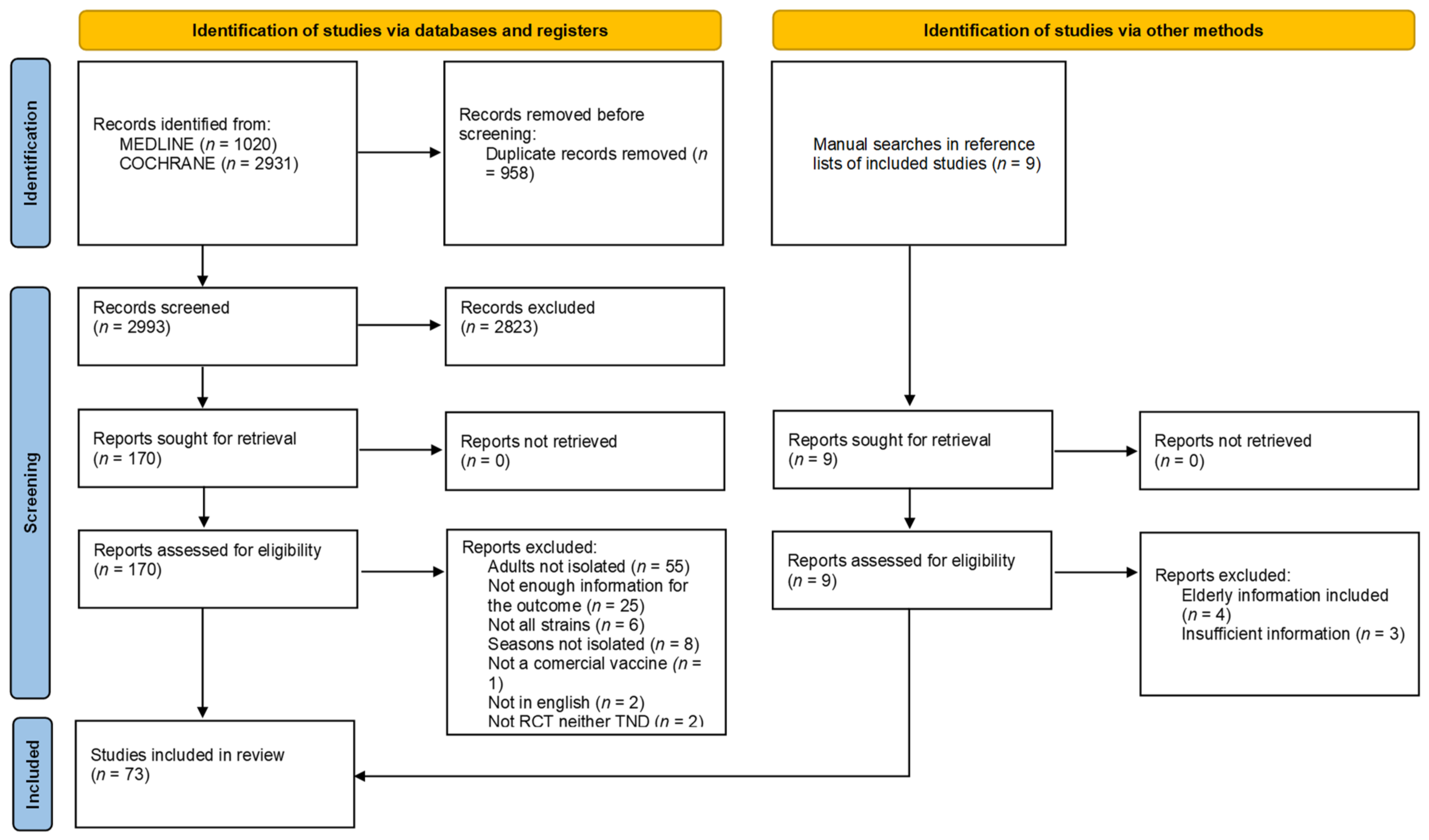
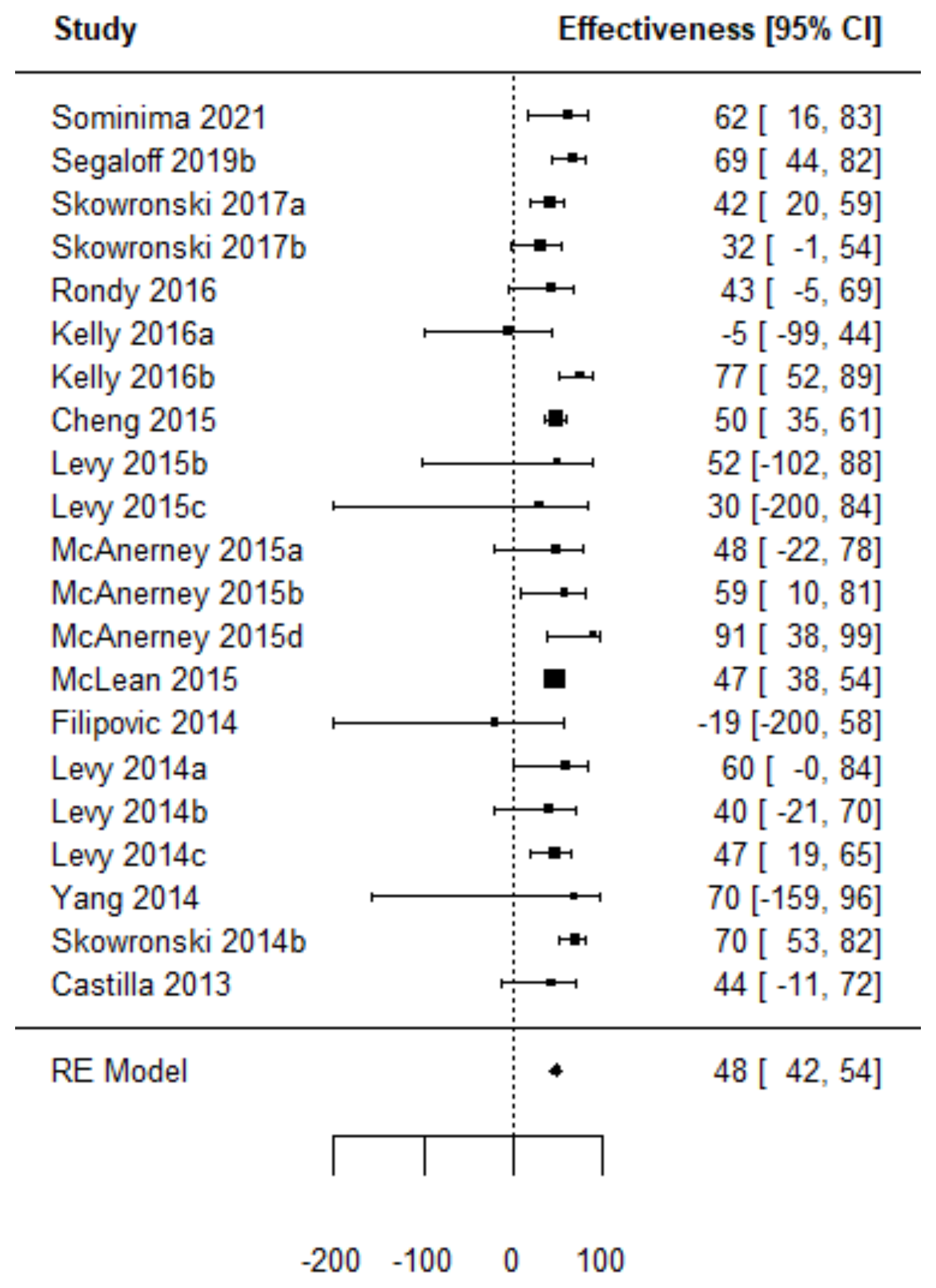
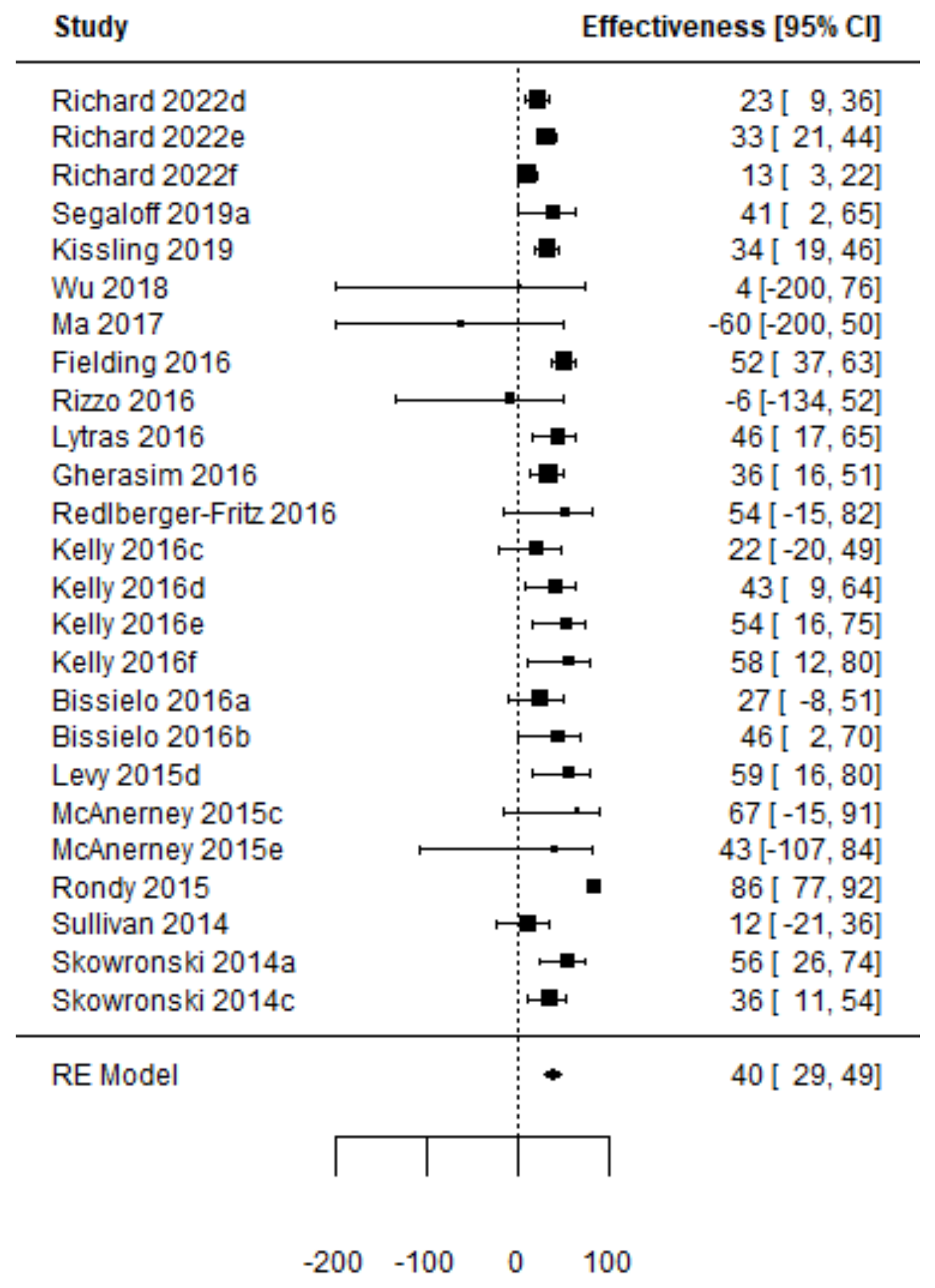
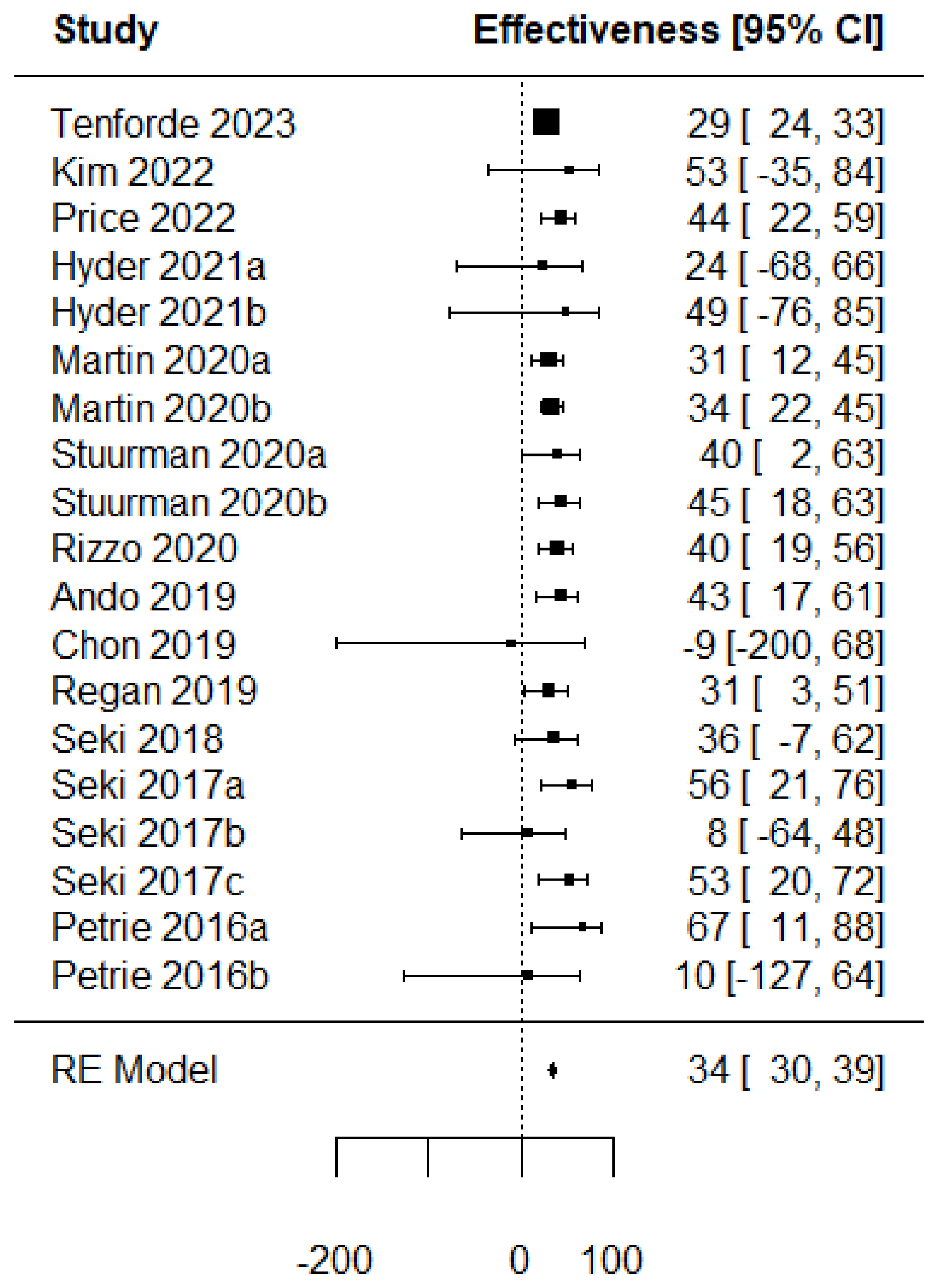
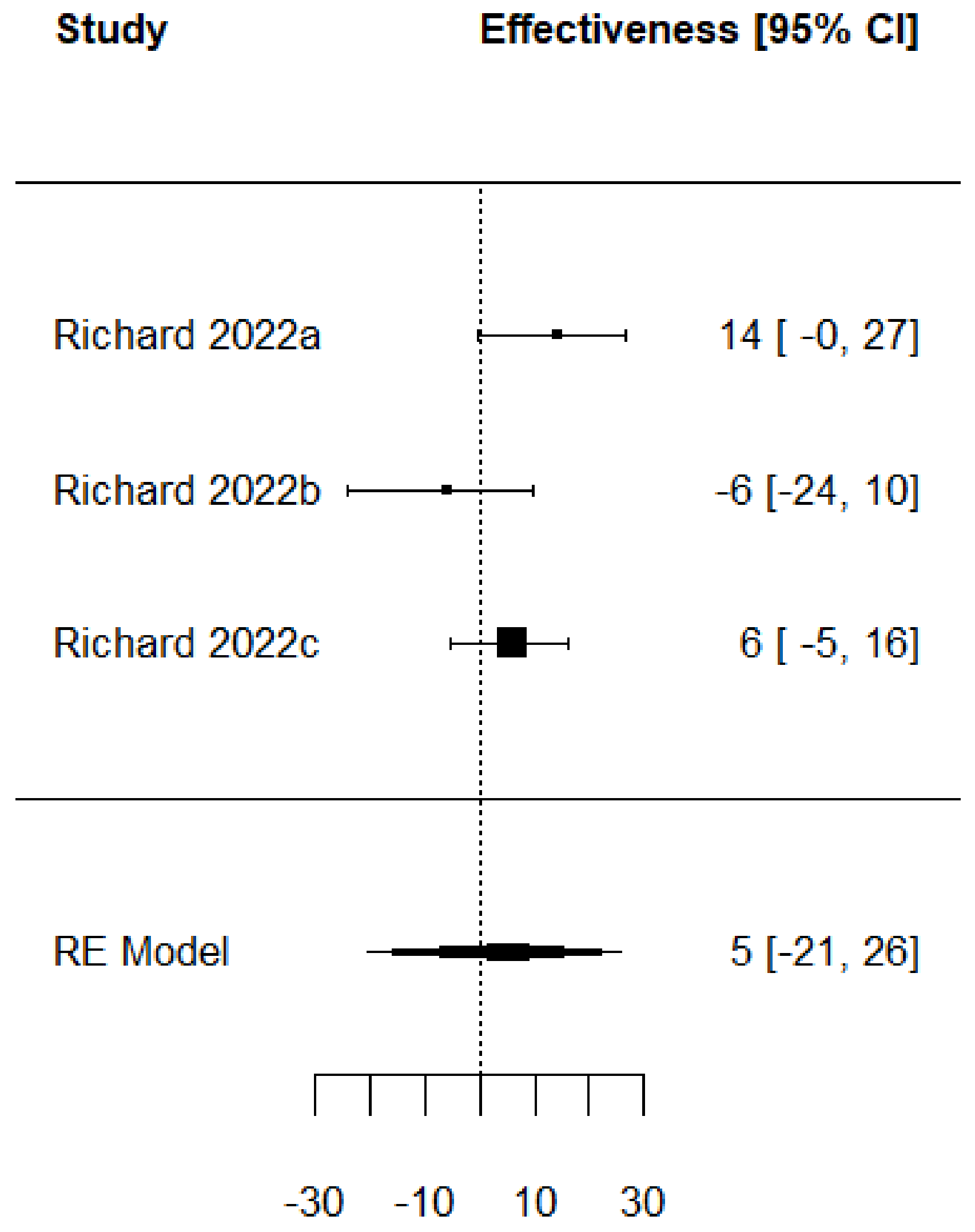
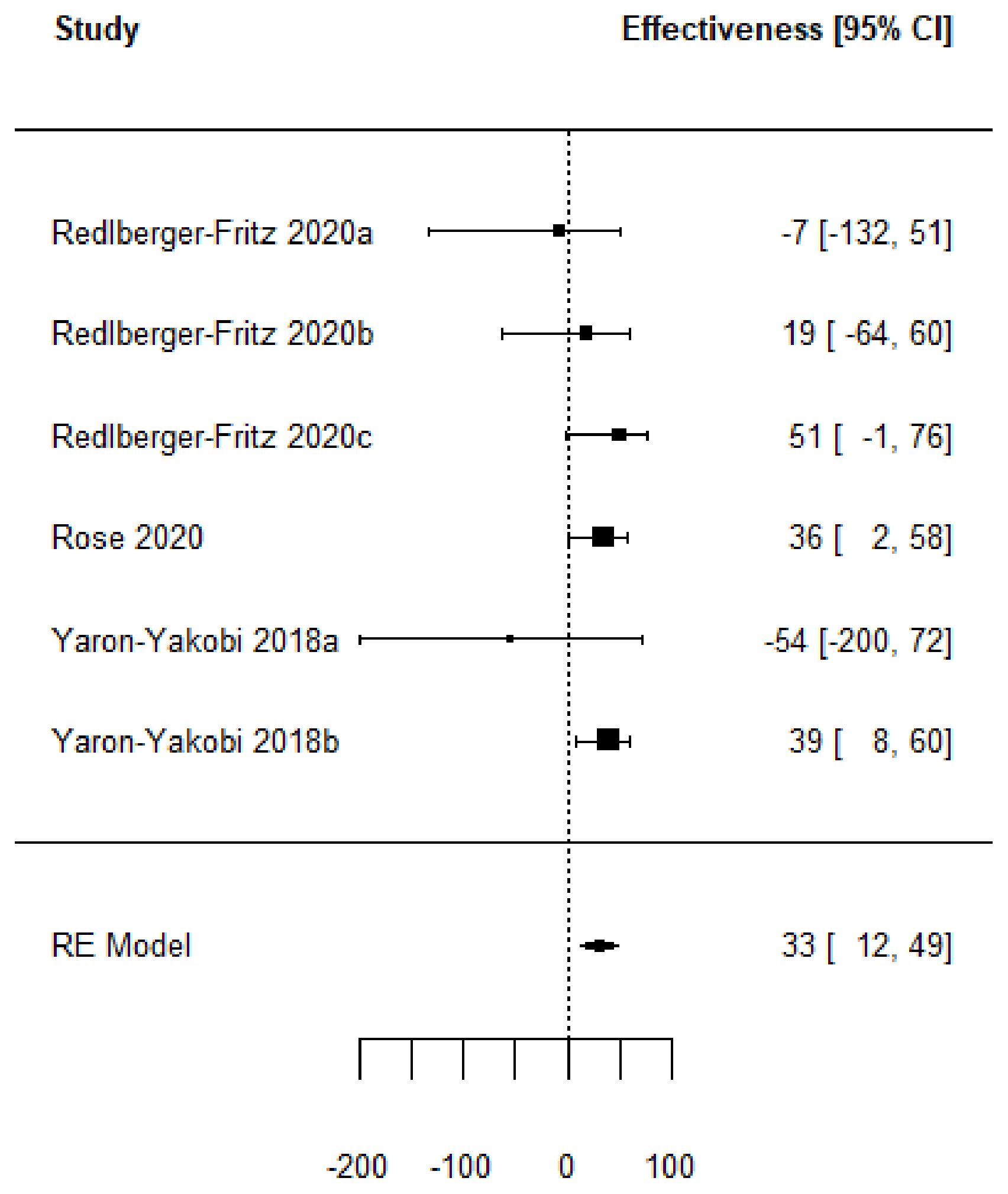
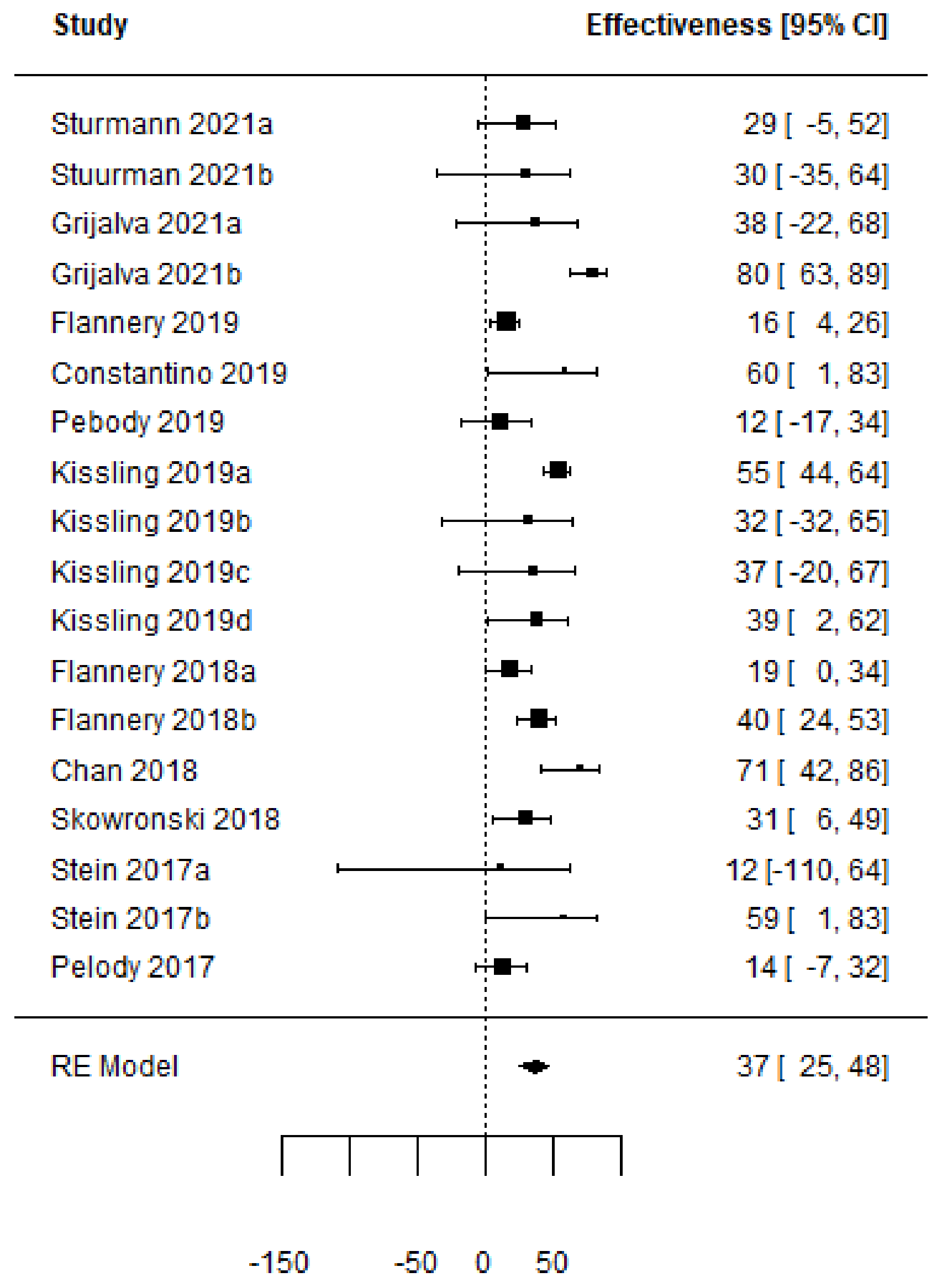

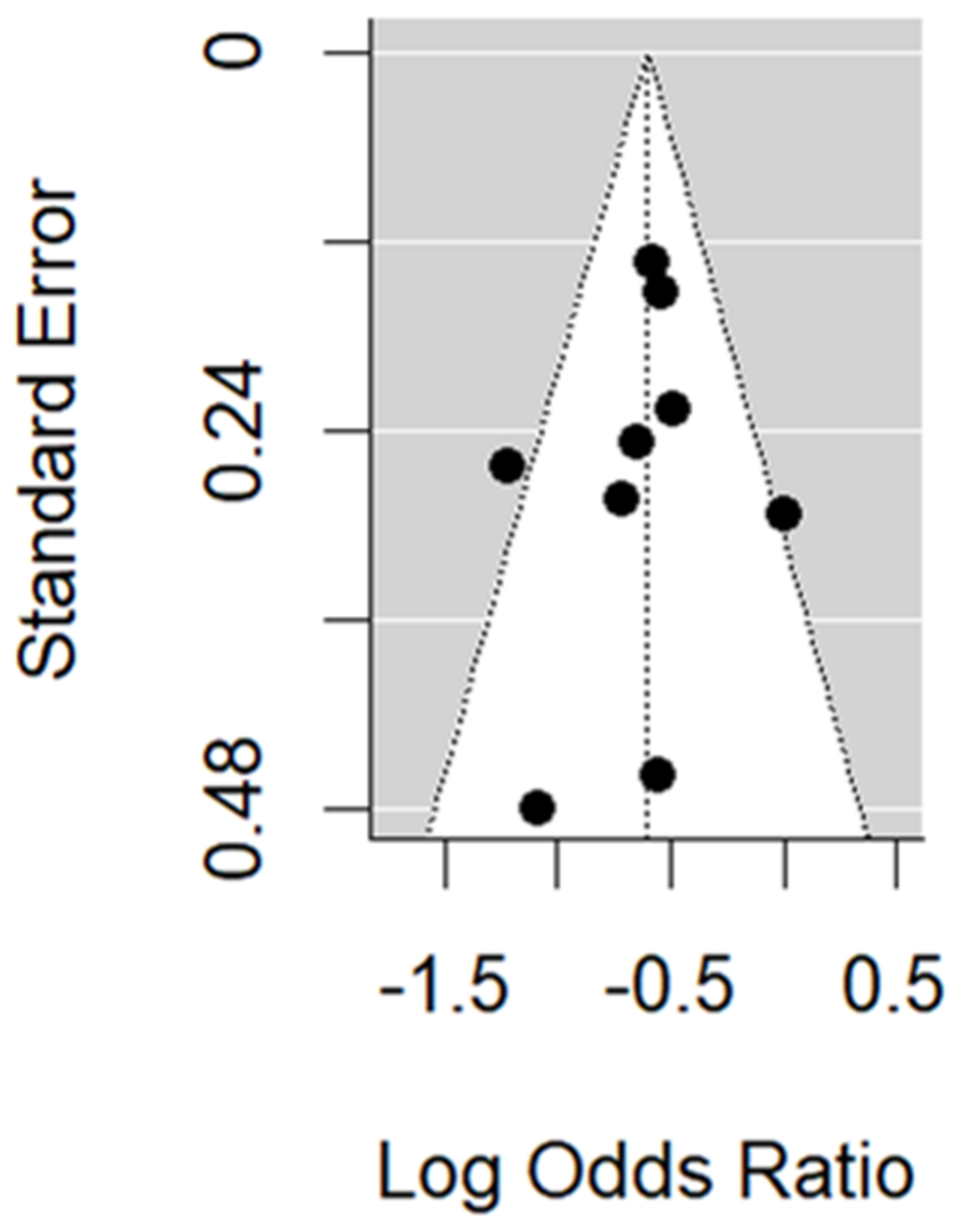
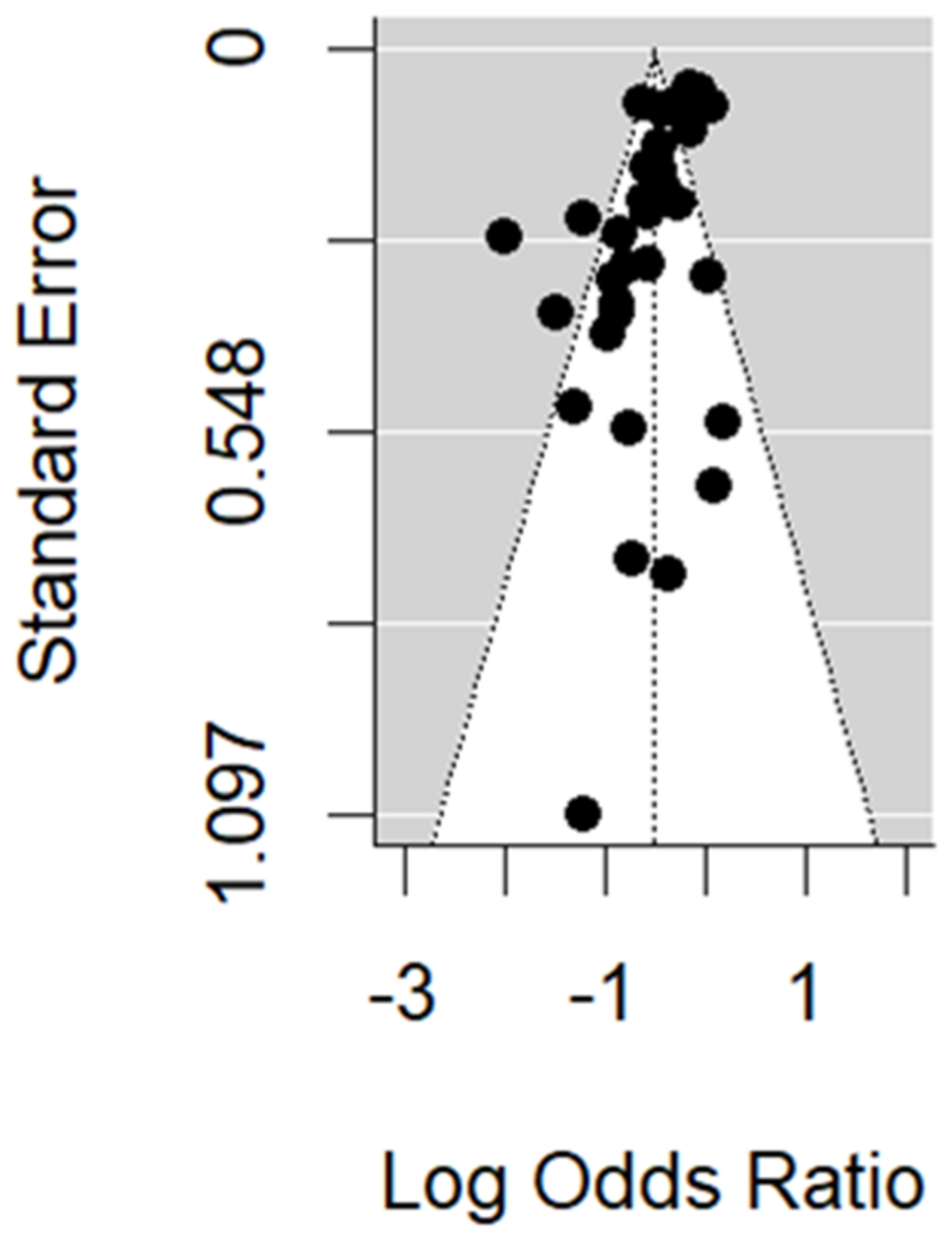
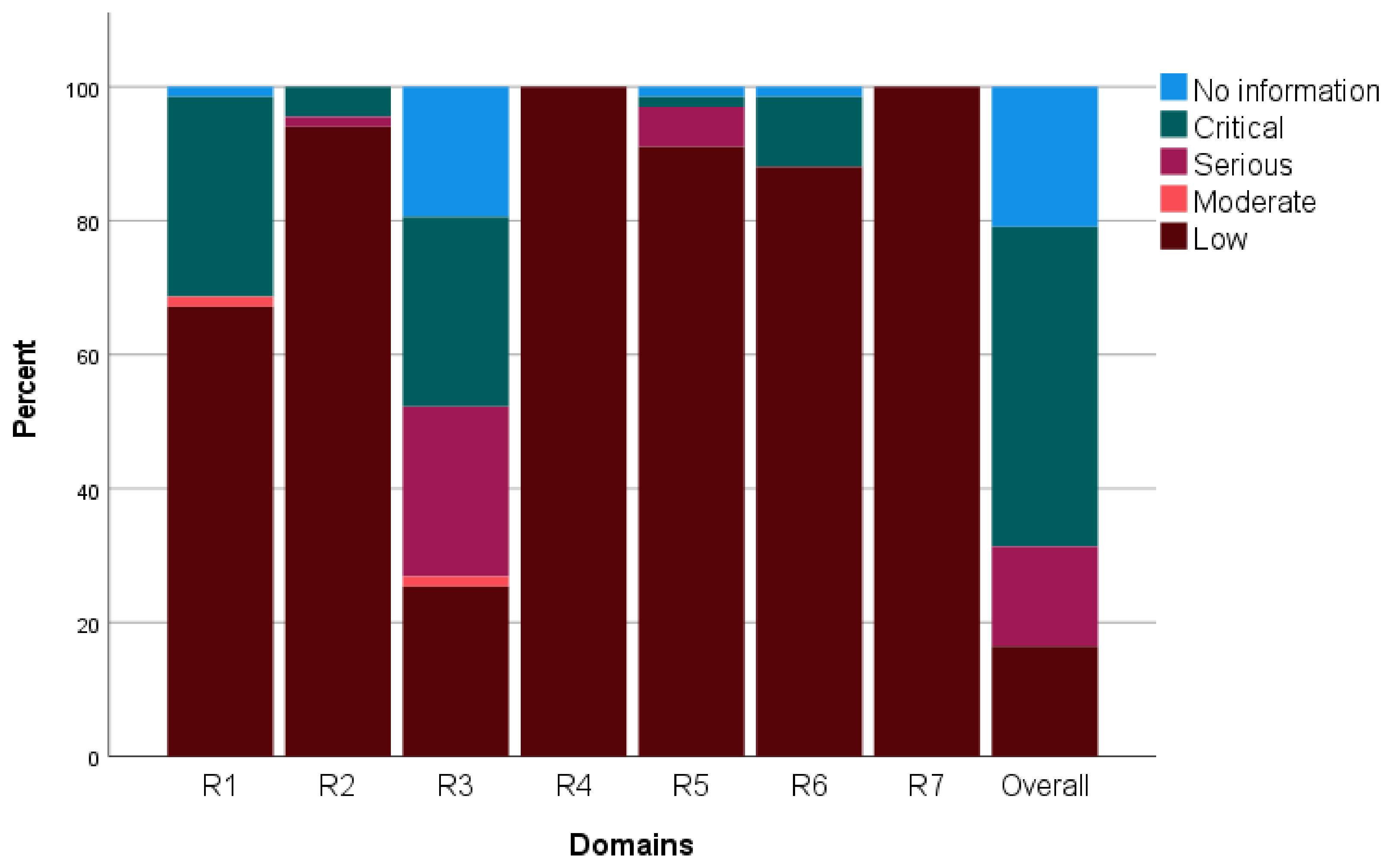
| Author | Country | Season | Vaccine | VE 100 (95% CI) | n | Strain Match | Test |
|---|---|---|---|---|---|---|---|
| Madhi 2014 [35] | South Africa | 2011–2012 | TIV | 51 (15–72) | 2049 | Mismatched | PCR |
| Madhi 2014 [35] | South Africa | 2011–2012 | TIV | 66 (13–87) | 188 | Unclear | PCR |
| Petrie 2016 [36] | USA | 2007–2008 | TIV | 70 (51–82) | 1139 | Matched | PCR |
| Petrie 2016 [36] | USA | 2007–2008 | LAIV | 39 (4–61) | 1138 | Matched | PCR |
| Mcbride 2016 [37] | Australia | 2008–2009 | TIV | 42 (22–57) | 7515 | Matched | PCR |
| Mcbride 2016 [37] | Australia | 2008–2009 | TIV | 44 (27–57) | 7334 | Unclear | PCR |
| Steinhoff 2017 [38] | Nepal | 2011–2012 | TIV | 48 (15–68) | 3693 | Unclear | PCR |
| Steinhoff 2017 [38] | Nepal | 2012–2013 | TIV | 0 (−78–43) | 3693 | Matched | PCR |
| Liebowitiz 2020 [39] | USA | 2012–2013 | QIV | 42 (−42–76) | 2049 | Matched | PCR |
| Author | Country | Season | Vaccine | VE 100 (95% CI) | n | Strain Match | Test |
|---|---|---|---|---|---|---|---|
| Kissling 2023 [40] | Europe | 2021–2022 | QIV and LAIV | 41 (25–64) | 6876 | Mismatched | PCR |
| Tenforde 2023 [41] | USA | 2021–2022 | QIV | 29 (24–33) | 59,150 | Mismatched | PCR |
| Kim 2022 [42] | Canada | 2021–2022 | QIV | 53 (−35–84) | 176 | Mismatched | PCR |
| Price 2022 [43] | USA | 2021–2022 | QIV | 44 (22–59) | 1850 | Mismatched | PCR |
| Richard 2022 [44] | USA | 2012–2013 | LAIV | 14 (0–27) | 2580 | Mismatched | PCR, RT, culture |
| Richard 2022 [44] | USA | 2013–2014 | LAIV | –6 (−24–10) | 2613 | Mismatched | PCR, RT |
| Richard 2022 [44] | USA | 2014–2015 | LAIV | 6 (−5–16) | 4715 | Mismatched | PCR, RT |
| Richard 2022 [44] | USA | 2012–2013 | TIV | 23 (9–36) | 2311 | Mismatched | PCR, RT |
| Richard 2022 [44] | USA | 2013–2014 | TIV | 33 (21–44) | 2517 | Mismatched | PCR, RT |
| Richard 2022 [44] | USA | 2014–2015 | TIV | 13 (3–22) | 5043 | Mismatched | PCR, RT |
| Sominina 2021 [45] | Russia | 2018–2019 | TIV | 62 (16–83) | 925 | Matched | PCR |
| Hyder 2021 [46] | India | 2017–2018 | QIV | 24 (−68–66) | 547 | Mismatched | PCR |
| Hyder 2021 [46] | India | 2018–2019 | QIV | 49 (−76–85) | 306 | Mismatched | PCR |
| Stuurmann 2021 [47] | Europe | 2019–2020 | TIV and QIV | 29 (−5–52) | 1055 | Mismatched | PCR |
| Stuurman 2021 [47] | Europe | 2019–2020 | TIV and QIV | 30 (−35–64) | 2041 | Mismatched | PCR |
| Grijalva 2021 [48] | USA | 2019–2020 | TIV and QIV | 38 (−22–68) | 638 | Mismatched | PCR |
| Grijalva 2021 [48] | USA | 2019–2020 | TIV and QIV | 80 (63–89) | Unclear | Mismatched | PCR |
| Hu 2021 [49] | USA | 2019–2020 | Unclear | 46 (36–55) | 5817 | Mismatched | PCR |
| Martin 2020 [50] | USA | 2016–2017 | QIV | 31 (12–45) | 2605 | Matched | PCR |
| Martin 2020 [50] | USA | 2017–2018 | QIV | 34 (22–45) | 3524 | Matched | PCR |
| Stuurman 2020 [51] | Europe | 2018–2019 | QIV | 40 (2–63) | 1095 | Matched | PCR, RT |
| Stuurman 2020 [51] | Europe | 2018–2019 | QIV | 45 (18–63) | 2036 | Matched | PCR, RT |
| Rizzo 2020 [52] | Italy | 2018–2019 | QIV | 40 (19–56) | 290 | Mismatched | PCR |
| Qahtami 2020 [53] | Saudi Arabia | 2018–2019 | TIV | 42 (14–64) | 556 | Unclear | PCR |
| Redlberger–Fritz 2020 [54] | Austria | 2016–2017 | QIV, TIV, aTIV, LAIV | −7 (−132–51) | 492 | Mismatched | PCR |
| Redlberger–Fritz 2020 [54] | Austria | 2017–2018 | QIV, TIV, aTIV, LAIV | 19 (−64–60) | 668 | Mismatched | PCR |
| Redlberger–Fritz 2020 [54] | Austria | 2018–2019 | QIV, TIV, aTIV, LAIV | 51 (−1–76) | 614 | Matched | PCR |
| Rose 2020 [55] | Europe | 2019–2020 | QIV, TIV, LAIV | 36 (2–58) | 13,630 | Mismatched | PCR |
| Ando 2019 [56] | Japan | 2018–2019 | QIV | 43 (17–61) | 555 | Unclear | RT |
| Segaloff 2019 [57] | USA | 2014–2015 | TIV | 41 (2–65) | 624 | Mismatched | PCR |
| Segaloff 2019 [57] | USA | 2015–2016 | TIV | 69 (44–82) | 441 | Matched | PCR |
| Flannery 2019 [58] | USA | 2018–2019 | TIV and QIV | 16 (4–26) | 5022 | Mismatched | PCR |
| Kissling 2019 [59] | Europe | 2016–2017 | TIV | 34 (19–46) | 5840 | Mismatched | PCR |
| Blanchette 2019 [60] | Canada | 2010–2011 | TIV | 34 (20–40) | 9288 | Unclear | PCR |
| Constantino 2019 [61] | Italia | 2018–2019 | TIV and QIV | 60 (1–83) | 308 | Probable | PCR |
| Pebody 2019 [62] | United Kingdom | 2017–2018 | TIV and QIV | 12 (−17–34) | 1896 | Unclear | PCR |
| Kissling 2019 [63] | Denmark | 2018–2019 | TIV and QIV | 55 (44–64) | 5807 | Mismatched | PCR |
| Kissling 2019 [63] | European Union | 2018–2019 | TIV and QIV | 32 (−32–65) | 1142 | Mismatched | PCR |
| Kissling 2019 [63] | United Kingdom | 2018–2019 | TIV and QIV | 37 (−20–67) | 575 | Mismatched | PCR |
| Kissling 2019 [63] | Denmark | 2018–2019 | TIV and QIV | 39 (2–62) | 727 | Mismatched | PCR |
| Chon 2019 [64] | Japan | 2015–2016 | QIV | −9 (−200–68) | 99 | Unclear | PCR, RT |
| Molgaard–Nielsen 2019 [65] | Denmark | 2010–2011 | TIV | 64 (29–82) | 626 | Unclear | Unclear |
| Regan 2019 [66] | Australia | 2016 | QIV | 31 (3–51) | 713 | Mismatched | PCR |
| Showronski 2019 [67] | Canada | 2017–2018 | Unclear | 63 (46–75) | 946 | Matched | PCR |
| Regan 2019 [68] | Australia | 2012 | TIV | 46 (22–63) | 825 | Unclear | PCR |
| Regan 2019 [68] | Australia | 2013 | TIV | 57 (26–75) | 577 | Unclear | PCR |
| Regan 2019 [68] | Australia | 2014 | TIV | 60 (41–73) | 1112 | Unclear | PCR |
| Regan 2019 [68] | Australia | 2015 | TIV | 50 (32–64) | 1491 | Unclear | PCR |
| Thompson 2018 [69] | USA | 2010–2011 | Unclear | 72 (−5–93) | 167 | Unclear | PCR |
| Thompson 2018 [69] | USA | 2011–2012 | Unclear | 47 (−98–86) | 84 | Unclear | PCR |
| Thompson 2018 [69] | USA | 2012–2013 | Unclear | 23 (−85–68) | 202 | Unclear | PCR |
| Thompson 2018 [69] | USA | 2013–2014 | Unclear | 51 (−30–82) | 200 | Unclear | PCR |
| Thompson 2018 [69] | USA | 2014–2015 | Unclear | 24 (−189–47) | 171 | Unclear | PCR |
| Thompson 2018 [69] | USA | 2015–2016 | Unclear | 40 (−33–72) | 216 | Unclear | PCR |
| Flannery 2018 [70] | USA | 2017–2018 | TIV and QIV | 19 (0–34) | 20,165 | Matched | PCR |
| Flannery 2018 [70] | USA | 2017–2018 | TIV and QIV | 40 (24–53) | 1362 | Matched | PCR |
| Chan 2018 [71] | China | 2017–2018 | TIV and QIV | 71 (42–86) | 383 | Unclear | PCR |
| Seki 2018 [72] | Japan | 2016–2017 | QIV | 36 (−7–62) | 299 | Matched | RT |
| Wu 2018 [73] | China | 2016–2017 | TIV | 4 (−200–76) | 6009 | Mismatched | PCR |
| Yaron–Yakobi 2018 [74] | Israel | 2014–2015 | QIV, TIV, LAIV | −54 (−200–72) | 417 | Mismatched | PCR |
| Yaron–Yakobi 2018 [74] | Israel | 2015–2016 | QIV, TIV, LAIV | 39 (8–60) | 783 | Mismatched | PCR |
| Skowronski 2018 [75] | Canada | 2017–2018 | TIV and QIV | 31 (6–49) | 895 | Unclear | PCR |
| Stein 2017 [76] | Israel | 2016–2017 | TIV and QIV | 12 (−110–64) | 151 | Matched | PCR |
| Stein 2017 [76] | Israel | 2016–2017 | TIV and QIV | 59 (1–83) | 165 | Matched | PCR |
| Pelody 2017 [77] | United Kingdom | 2017–2018 | TIV and QIV | 14 (−7–32) | 1896 | Mismatched | PCR |
| Skowronski 2017 [78] | Canada | 2015–2016 | TIV | 42 (20–59) | 1076 | Matched | PCR |
| Skowronski 2017 [78] | Canada | 2015–2016 | TIV | 32 (−1–54) | 520 | Matched | PCR |
| Kuliese 2017 [79] | Lithuania | 2015–2016 | TIV | 61 (−345–97) | 72 | Unclear | PCR |
| Ma 2017 [80] | China | 2014–2015 | TIV | −60 (−200–50) | 4990 | Mismatched | PCR |
| Seki 2017 [81] | Japan | 2013–2014 | QIV | 56 (21–76) | 262 | Unclear | RT |
| Seki 2017 [81] | Japan | 2014–2015 | QIV | 8 (−64–48) | 235 | Unclear | RT |
| Seki 2017 [81] | Japan | 2015–2016 | QIV | 53 (20–72) | 427 | Matched | RT |
| McAnerney 2016 [82] | South Africa | 2015 | TIV | 54 (−14–82) | 599 | Unclear | PCR |
| Fielding 2016 [83] | Australia | 2015 | TIV | 52 (37–63) | 1492 | Mismatched | PCR |
| Petrie 2016 [84] | USA | 2014–2015 | QIV | 67 (11–88) | 165 | Mismatched | PCR |
| Petrie 2016 [84] | USA | 2014–2015 | QIV | 10 (−127–64) | 239 | Mismatched | PCR |
| Rizzo 2016 [85] | Italy | 2014–2015 | TIV | −6 (−134–52) | 1183 | Mismatched | PCR |
| Lytras 2016 [86] | Greece | 2014–2015 | TIV | 46 (17–65) | 363 | Mismatched | PCR |
| Rondy 2016 [87] | France, Italy e Spain | 2013–2014 | TIV | 43 (−5–69) | 305 | Matched | PCR |
| Gherasim 2016 [88] | Spain | 2014–2015 | TIV | 36 (16–51) | 2957 | Mismatched | PCR |
| Redlberger–Fritz 2016 [89] | Austria | 2014–2015 | TIV | 54 (−15–82) | 532 | Mismatched | PCR |
| Kelly 2016 [90] | Australia | 2011 | TIV | −5 (−99–44) | 227 | Matched | PCR |
| Kelly 2016 [90] | Australia | 2011 | TIV | 77 (52–89) | 409 | Matched | PCR |
| Kelly 2016 [90] | Australia | 2012 | TIV | 22 (−20–49) | 415 | Mismatched | PCR |
| Kelly 2016 [90] | Australia | 2012 | TIV | 43 (9–64) | 460 | Mismatched | PCR |
| Kelly 2016 [90] | Australia | 2013 | TIV | 54 (16–75) | 190 | Mismatched | PCR |
| Kelly 2016 [90] | Australia | 2013 | TIV | 58 (12–80) | 258 | Mismatched | PCR |
| Bissielo 2016 [91] | New Zealand | 2015 | TIV | 27 (−8–51) | 618 | Mismatched | PCR |
| Bissielo 2016 [91] | New Zealand | 2015 | TIV | 46 (2–70) | 246 | Mismatched | PCR |
| Cheng 2015 [92] | Australia | 2014 | TIV | 50 (35–61) | 1234 | Matched | PCR |
| Levy 2015 [93] | Thailand | 2009–2010 | TIV | 73 (26–90) | 240 | Mismatched | PCR |
| Levy 2015 [93] | Thailand | 2010–2011 | TIV | 52 (−102–88) | 62 | Matched | PCR |
| Levy 2015 [93] | Thailand | 2011–2012 | TIV | 30 (−200–84) | 129 | Matched | PCR |
| Levy 2015 [93] | Thailand | 2012–2013 | TIV | 59 (16–80) | 411 | Mismatched | PCR |
| McAnerney 2015 [94] | South Africa | 2010 | TIV | 48 (−22–78) | 354 | Matched | PCR |
| McAnerney 2015 [94] | South Africa | 2011 | TIV | 59 (10–81) | 548 | Matched | PCR |
| McAnerney 2015 [94] | South Africa | 2012 | TIV | 67 (−15–91) | 749 | Mismatched | PCR |
| McAnerney 2015 [94] | South Africa | 2013 | TIV | 91 (38–99) | 460 | Matched | PCR |
| McAnerney 2015 [95] | South Africa | 2014 | TIV | 43 (−107–84) | 812 | Mismatched | PCR |
| Rondy 2015 [96] | Europe | 2012–2013 | TIV | 86 (77–92) | 564 | Mismatched | PCR |
| McLean 2015 [97] | USA | 2012–2013 | TIV | 467 | 3307 | Matched | PCR |
| Filipovic 2014 [98] | Croatia | 2010–2011 | TIV | −19 (−200–58) | 240 | Matched | PCR |
| Turner 2014 [99] | New Zealand | 2014 | TIV | 59 (23–79) | 190 | Unclear | PCR |
| Turner 2014 [99] | New Zealand | 2014 | TIV | 57 (28–74) | 498 | Unclear | PCR |
| Levy 2014 [100] | Australia | 2010 | TIV | 60 (0–84) | 355 | Matched | PCR |
| Levy 2014 [100] | Australia | 2011 | TIV | 40 (−21–70) | 348 | Matched | PCR |
| Levy 2014 [100] | Australia | 2012 | TIV | 47 (19–65) | 804 | Matched | PCR |
| Yang 2014 [101] | China | 2012–2013 | TIV | 70 (−159–96) | 1246 | Matched | Virus isolation |
| Sullivan 2014 [102] | Australia | 2012 | TIV | 12 (−21–36) | 926 | Mismatched | PCR |
| Skowronski 2014 [103] | Canada | 2011–2012 | TIV | 56 (26–74) | 975 | Mismatched | PCR |
| Skowronski 2014 [104] | Canada | 2013–2014 | TIV | 70 (53–82) | 562 | Matched | PCR |
| Skowronski 2014 [105] | Canada | 2012–2013 | TIV | 36 (11–54) | 979 | Mismatched | PCR |
| Kavanagh 2013 [106] | Scotland | 2010–2011 | TIV | 100 (−349–100) | 457 | Matched | PCR |
| Castilla 2013 [107] | Spain | 2011–2012 | TIV | 44 (−11–72) | 650 | Matched | PCR |
| Match | Mismatch | p-Value | (%) | |
|---|---|---|---|---|
| All vaccines | 55.4 (43.2,64.9) | 39.3 (23.5, 51.9) | 0.068 | 0.01 |
| TIV | 59.4 (46.4,69.2) | 39.3 (23.5, 51.9) | 0.035 * | 0 |
| Yes | No | p-Value | (%) | |
|---|---|---|---|---|
| Adjusted estimate? | 39.9 (30.5–47.9) | 41.0 (36.8–44.9) | 0.419 | 77.9 |
| TIV? a | 44.9 (39.1–50.1) | 30.3 (22.0–37.7) | 0.010 * | 76.9 |
| Match circulating strains, TIV? b | 48.3 (41.7–54.2) | 40.1 (29.1–49.4) | 0.080 | 61.4 |
| QIV? c | 34.3 (29.6–38.7) | 42.7 (36.4–48.3) | 0.454 | 80.8 |
| LAIV? d | 5.4 (−20.7–25.9) | 41.4 (37.1–45.4) | 0.001 ** | 78.5 |
| Match circulating strains? e | 45.1 (38.7–50.8) | 35.1 (29.0–40.7) | 0.017 * | 69.8 |
| Not only ILI? f | 38.7 (33.5–43.5) | 43.9 (37.7–49.5) | 0.176 | 73.9 |
| Not only outpatients? g | 43.1 (33.2–51.6) | 39.6 (35.1–43.8) | 0.497 | 80.3 |
| Only PCR? h | 42.7 (38.3–46.8) | 29.7 (20.4–37.9) | 0.012 * | 76.3 |
| Northern Hemisphere? | 39.1 (34.4–43.4) | 44.7 (36.1–52.2) | 0.196 | 80.2 |
Disclaimer/Publisher’s Note: The statements, opinions and data contained in all publications are solely those of the individual author(s) and contributor(s) and not of MDPI and/or the editor(s). MDPI and/or the editor(s) disclaim responsibility for any injury to people or property resulting from any ideas, methods, instructions or products referred to in the content. |
© 2023 by the authors. Licensee MDPI, Basel, Switzerland. This article is an open access article distributed under the terms and conditions of the Creative Commons Attribution (CC BY) license (https://creativecommons.org/licenses/by/4.0/).
Share and Cite
Martins, J.P.; Santos, M.; Martins, A.; Felgueiras, M.; Santos, R. Seasonal Influenza Vaccine Effectiveness in Persons Aged 15–64 Years: A Systematic Review and Meta-Analysis. Vaccines 2023, 11, 1322. https://doi.org/10.3390/vaccines11081322
Martins JP, Santos M, Martins A, Felgueiras M, Santos R. Seasonal Influenza Vaccine Effectiveness in Persons Aged 15–64 Years: A Systematic Review and Meta-Analysis. Vaccines. 2023; 11(8):1322. https://doi.org/10.3390/vaccines11081322
Chicago/Turabian StyleMartins, João Paulo, Marlene Santos, André Martins, Miguel Felgueiras, and Rui Santos. 2023. "Seasonal Influenza Vaccine Effectiveness in Persons Aged 15–64 Years: A Systematic Review and Meta-Analysis" Vaccines 11, no. 8: 1322. https://doi.org/10.3390/vaccines11081322
APA StyleMartins, J. P., Santos, M., Martins, A., Felgueiras, M., & Santos, R. (2023). Seasonal Influenza Vaccine Effectiveness in Persons Aged 15–64 Years: A Systematic Review and Meta-Analysis. Vaccines, 11(8), 1322. https://doi.org/10.3390/vaccines11081322








